#but the fabrics tend to be a little more…traditional?
Text

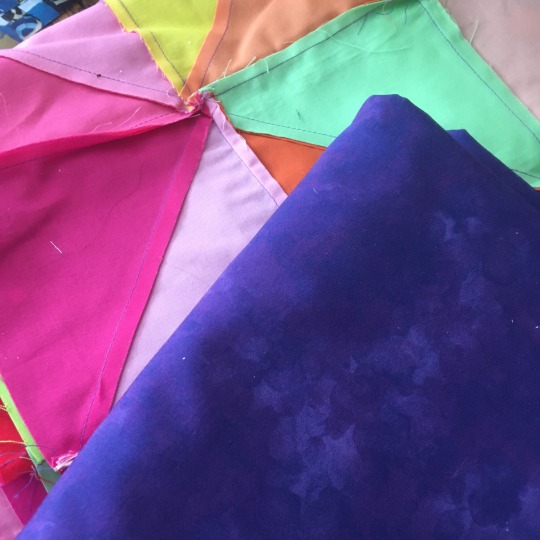
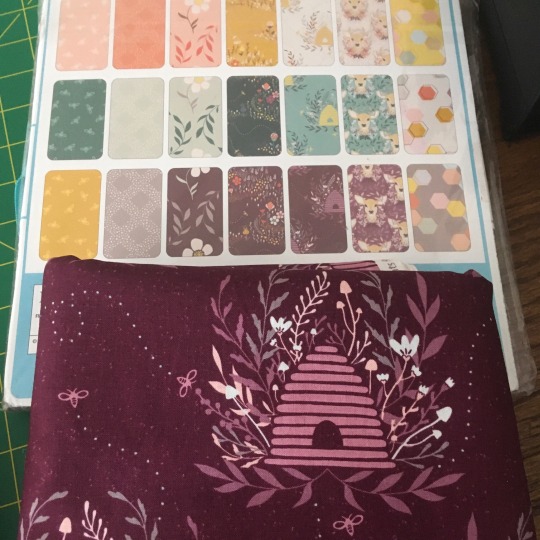

Hey y’all! Which quilt should I work on next? I went to some new (to me) quilt shops and now I have a few options
1. Finally quilt the pink and green watercolor floral chevron quilt top (in my defense, I only got the backing fabric today)
2. Finally quilt the rainbow triangle quilt (I have no defense I’ve had the backing fabric for a while lol)
3. Make a purple bee layer cake quilt
4. Make a SUPER COLORFUL rainbow batik jelly roll quilt and finally use up the backing fabric I originally bought for the rainbow triangle quilt and then my grandma was like “no you can’t use it for that”
#what to quilt next#options!! I’m so excited#the local quilt shops two towns over are SO COOL#Like. the local local quilt shop is nice#but the fabrics tend to be a little more…traditional?#one of the other quilt shops is called ‘the bright quilt shop’ by their customers#unsurprisingly I LOVED the bright quilt shop#and the other quilt shop had fat quarters everywhere and a fabric line I’ve had in my online shopping cart like five times but not bought#so colorful so cool I’m so happy they exist
22 notes
·
View notes
Text
how to steal a heart (I)

[ a dummy's guide on how to steal the heart of a poor pathetic man ]
- Warning: Yes, this is still a yandere thing. You have been warned. Female reader.
- Note: This has been an idea (heavily inspired by Howl's Moving Castle) I had in my docs since fall 2022. I was talking to a mutual about how writing on Tumblr vs Quotev feels very different. If I leave something unfinished on Quotev, I feel incredibly guilty which prevents me from posting new stories. However, on Tumblr, I don't feel as guilty. Not sure why. Anyways, I know most of my followers here don't care for my ocs, and I've been wanting to post this for so long. So instead of posting on Quotev, I'll post it on here just to get rid of the urge to share this story (might delete this later). This is the same story I posted that little screenshot of not too long ago, and that screenshot was basically just the prologue chapter. So yeah. Hope you enjoy?
IN WHICH THERE IS A SEAMSTRESS . . .
Black smoke concealed the window like a thick veil as the walls around her shook. It was a sure sign that the train was inching by. The screech from its whistle and clanking against the railroad tracks, so loud that it must’ve been heard over a mile away, only confirmed her guess. Her hands continued to cut smoothly through the linen fabric, separating enough to fulfill another order placed this morning. As the young woman worked to separate the colors and gather more material, the corner of her eyes caught sight of the smoke concealing her perfect view.
The train’s fading motion and clanging against the tracks was eventually replaced by chatter just outside her workshop. It all became background noise, as she began to utilize the sewing machine. Lines formed over the cloth, blending it and connecting so they formed an article of clothing. Needles, pins, and scissors cut and dug deep through the cloth. Buttons of all shapes and sizes were neatly organized in little boxes, so she could easily take what she needed. Time just seemed to fly as she worked so quietly and efficiently, oblivious to the hours ticking by. Any other noise fell on deaf ears, even as a knock resounded on the firm wooden door that happened to be wide open already.
A pause before the person tried again, knocking a little louder again. “(Y/n)?”
Snapping out of her efficient trance, the tailor snapped to attention and straightened her sitting posture. Gazing at the door and back the window where the sun was much lower than before, it took her a moment to figure out what exactly was going on and what time it was. It was later in the day, and the woman at the door was Dalena… Well, everyone called her Ma Dalena because she was a kind older lady who tended to see the young female tailors as her own children. At least, most of the tailors.
“We closed up five minutes ago. You can go now.” Ma Dalena gave an encouraging smile that displayed the dimples on her skin, showing signs of age evident by the wrinkles. Judging by her long dress and small woven handbag hanging from her wrist, it was probably safe to assume that she had evening plans. “Why not spend the rest of the day with us?”
Us. Correct she was again. As welcoming as the invitation was to join Ma Dalena and the other tailors, she wasn’t willing to join them anymore. Not after the first time when she dared to venture with them. After shifts, the tailors had a tradition of going out into town. Not that it was a bad thing. But they used their time cafe hopping, searching for flirtatious men to satisfy their need for affection. Oftentimes, they would get caught up with the pushy kind. And ever since some troops from the military have returned from their duties, well… encountering a bunch of men who hadn’t felt the touch of a woman in months, was not ideal. At least for her.
Taking her foot off the pedal to pause her work and silence the sewing machine, she pretended to consider the invitation before mustering a polite smile with a shake of her head. “Hm… It sounds nice. But I promised the client I would finish this so they can pick it up tomorrow. So I’ll stay, but have fun. Have another drink in my place, alright?”
Ma Dalena merely nodded in understanding, her polite smile turning somber as she turned on her two-inch heels and began walking to the front entrance. The chatter of the other tailors ready and eager for the rest of the day off, went quiet as she announced, “We’re leaving now. Hurry now if you’re coming!”
The chatter resumed, accompanied by the sound of more heels tapping quickly against the wooden floors in an effort for the straying members to catch up with the group. They complimented each other's outfits they spent days making by hand, discussing various fashion trends, gossiping about clients and others in town.
In a way, she did and she didn’t regret accepting the invitation. It may have been nice to have good company for once, but it never felt right when she was present within their clique. It was as if she were trying to forcefully add a puzzle piece to an already complete puzzle, which is why she stopped forcing it. She wouldn’t want to sit there awkwardly during tea, unsure what to say as they spoke so confidently and loudly. It felt as if she were an imposter, someone trying to disguise themselves to blend in. It was why she worked in a small separate room, away from everyone else. That, and because she was the fastest tailor there. Part of her wondered if Ma Dalena was beginning to dislike her since she turned down invitation after invitation. But how was she to explain what she was feeling, when it would only sound like whining?
Drowning out her thoughts with work to occupy the space in her mind, she pressed her foot against the pedal and began sewing once more. The loud hum of the machine filled her ears as it worked against the red cloth under her fingertips. This was the way it was supposed to be. Mindlessly spending her waking hours working at a craft she didn’t excel at, but was decent enough to earn wages in. All while wondering what could’ve been, and secretly hoping that maybe soon there is something that can be––
“Look! Look out there! It’s Reyes’ temple!”
“Reyes?!”
“Where? I don’t see it!”
“There! Over the hill!”
Now that was something you don’t see everyday. Everyone retreated back to the window, desperate to catch a glimpse, even Ma Dalena. Halting her work once again, (Y/n) too was the tiniest bit curious.
In truth, magicians failed to interest her, not that she had an opportunity to see them much anyways. But all those in Etére knew to be cautious of two particular magic wielders: La Bruja de Bruez, the Witch of Bruez, and Reyes Ladrón de Corazones, Reyes the Thief of Hearts. The pair were like the local boogeymen, tales of their horrendous deeds spreading and becoming bedtime stories for children in order to scare them into good behavior.
Ever since her youth, she heard stories of La Bruja de Bruez. It was said that she was a wicked woman who’s lived for over a hundred years. A slight against her is taken seriously, and she curses those she comes across. But she was no mere fairytale. The witch has been a thorn in the country’s side for a long time, as she terrorizes the towns she visits. There hasn’t been much action taken against her, because she’s so powerful that hardly anyone stands a chance and she’s so elusive. Besides, the royal family don’t particularly care if the witch curses a random citizen every month or so, as long as they don’t have to risk pawns in their own arsenal of magicians just to take her down.
Only a few years ago, a second magician with fearsome spells and a horrible reputation, appeared. Reyes Ladrón de Corazones, or more commonly known as Reyes, was another brujo many feared, although not as much as his counterpart from Bruez. There were rumors, yes, but they were more lighthearted with little evidence to ever back up the claims. While the Bruja de Bruez spared no one, it was said that Reyes chose to pursue only young beautiful women. If you asked around town, half of the population would consider him a threat, while the other half would giggle and whisper about his rumored good looks. Maybe that’s how he lured them in? With charms. Either way, he was a cause for concern. It was said that at a young age after abandoning his position as apprentice under the royal sorceress, the most powerful known magician, he not only challenged her but won and stripped her of her powers. Of course, no one can neither confirm nor deny it, as the king kept a tight lid on the situation and supposedly those who approach Reyes meet a terrible fate. But his abode was proof enough of his sheer strength. It was like a castle, a temple wandering on mechanical legs, rumored to not only be fueled by magic but also made of it.
Through the mist and low hanging clouds, just over the rolling hills on the horizon she could make out the distinct shape of a temple. A magnificent temple that appears so small from so far away. But she knew that it was a beast, a titan wandering the wilderness where very few dared to venture. It prowled around on its mechanical legs, spewing black smoke as the only trail it left behind. Reyes’ moving temple disappeared behind the clouds, seemingly vanishing from sight. Onlookers within the tailor shop could only awe and wonder aloud what the brujo was like, what was true and what was not, their minds creating horrible fears and outlandish fantasies that would take root as rumors.
Lowering her gaze back to her work, she resumed once more, but the rumors overpowered the hum of her machine until their words reached her. The other tailors proceeded back to the front entrance, marveling about what they just witnessed. Was he hiding from soldiers practicing their flights just outside the town? Did you hear that he literally steals the hearts of women, but only beautiful ones? Someone said that a pretty waitress on the other side of town had her own heart torn out and stolen by Reyes just last week!
The door was shut and she was alone, left with her work and the noise outside. Swiftly she worked, able to repair tears and wears with ease and create other things. Able to get lost in the work for much longer, until she felt the ground shake and the screech of another whistle. The afternoon train. It’s smoke covering her window once again. It was getting late already. Not wishing to waste the rest of the day by continuing work or go to bed with a book she had already read twice, she switched off the machine and organized all the tools back into their places. Brushing off all stray strings from her dress, she then rearranged her completed work thus far and prepared to have a different kind of day.
Today, she would try to make it a can be sort of day. Even if it meant just visiting a close friend like Lía at the bakery. Just putting out the effort to go out today was more than she was usually willing. Although wishing it would be something special, a proper can be day without even trying, was like wishing to be acknowledged by a person you admire but never once talked to, it was much like winging it on a test without studying and praying you would get a perfect score even though knowing that it’s almost near impossible. But it isn’t statistically completely impossible, so you cling to that thin shred of hope that’s as taut as a piece of string.
The whirring of small planes buzzed overhead, the flying machines brandishing their flags like the proud and numerous soldiers. On nearly every home and business, there was the flag hanging over the door, a symbol of patriotism and support of the war effort. (Y/n) quickly crossed the streets and reached the trolley station that would take her further into town. Right now there was not a soldier in sight, but that was sure to change the closer to the center of town she got. She only prayed that there wouldn’t be any trouble with them.
The trolleys were full, people all going towards the center of town, in the same direction the planes overhead flew towards. If she had to guess, most of the people within the trolley were likely friends or family of returning soldiers. All giddy from the victory high of a major battle just won.
While watching the scenery go by, she wondered how Lía was fairing.
It was because of Lía and her family that she now worked in a tailor shop. (Y/n)’s parents had met an unfortunate end while traveling outside the kingdom. They were doctors dedicated to a good cause, determined to stay in dangerous war torn lands to heal and treat the poorest of folks. While she was busy with school and often alone but checked on by family friends, her parents were saving people an ocean away in a faraway land where Milavi’s war had spread. They had been too close to Milavi claimed territory, likely mistaken for doctors healing rebels, and were thus punished for their good deeds. With no one left to turn to, her family’s closest friend, Señor Obregón, adopted (Y/n) and treated her as one of his own.
Señor Obregón was a quiet but respectable man that spent his time either working or with his family. He was the one that taught her how to sew, knit, and tailor, after she became curious of his skills. There were two other girls, Lía and Cova, a few years younger than (Y/n), which is why she became the oldest sibling. Lía was the beauty admired all throughout their childhood and still beloved to this day. She most resembled her mother, but she wasn’t half as vain. Cova was the youngest and somehow the smartest, as she was able to quickly grasp the concepts from lessons even in (Y/n)’s class, despite being a few grade levels apart. She mostly resembled her father and his own wits. Then there was her, (Y/n), who had… whatever was left. Of course she never held any resentment toward her sisters, since they were always well behaved but perhaps a bit annoying with their squabbles. Lastly, was Señora Obregón, Rosita, who she just called Tia Rosa for short, was never rude or dismissive to her. Tia Rosa was actually very outgoing and talkative, but she was the sort of woman that wouldn’t be caught dead wearing something from last season. She desired the finer things in life and settled for no less, which is probably why Señor Obregón ended up in an early grave due to working himself to death just to try and afford the luxuries his wife craved.
Immediately after the funeral, while they were still dressed head-to-toe in black and their eyes were puffy from crying, Rosita sat all three of her daughters for a conversation about the future. It would be impossible for her to keep them all in school, especially considering she hadn’t worked a day in her life. However, she wasn’t cruel enough to just toss her young girls out into the streets with nowhere to go. So, she devised a plan for each girl. Cova would be able to best utilize her smarts in a challenging field full of promise, which is why she was sent to a good witch in the next town over, to become an apprentice in magic. Lía was already very popular around town, she would thrive in a social environment like the bakery on main street where to this day men constantly asked for her hand. As for her, (Y/n), she would stay here in Obregón’s tailor shop, where Tia Rosa deemed was best fit. Afterall, she did know how to carry on the business, she had even helped their reputation grow substantially as more people came in every day and profits increased. Although, she hardly had the time to spend the earnings on herself, that’s what Tia Rosa was there for. Rather, never there for. She’d collect earnings from the business (Y/n) ran and would disappear for weeks or months at a time to another town or city. But that's besides the point…
By now, the trolley she was on was near the center of town that happened to be within blocks away, the streets became crowded with people walking on foot. On roads below bridges, there were lines of military tanks rolling by. Not much further in, the sidewalks were jam packed with hundreds, upon thousands, of people. Confetti rained down, banners and flags were strung from every corner and door. Every window was occupied as citizens cheered and waved at the parade of temporary victors, a show of military strength. Soldiers in their crisp uniforms marched in unified lines, cavalry on horseback carried large flags.
As the density of the crowds increased, and the volume of cheers and the parade along with it, she felt her heart beat louder. This was too much, it was too loud, she couldn’t even think…! But she had come this far, to go back home now when she was so close would be a little pathetic. Avoiding the commotion like a plague, she decided it best to take the maze of alleyways to calm her nerves. There were hardly any people on those backstreets, just the occasional stationed soldier. Focusing her gaze on the war propaganda posters on the brick and clay walls underneath window boxes filled with colorful flowers, she pretended to carefully study them as she increased her pace from a calm stroll to a quick speed walk, examining the items as if they were the most fascinating objects she ever saw. Really, she’d rather not make awkward eye contact with the soldiers on guard that watched her like a hawk, which is why she hurried along until they were out of sight.
Now that she was alone, with the crowds and their entertainment separated from her by walls of homes and businesses, she felt relief as the once loud sounds melted into background noise. For now she could concentrate on the address scribbled out on the folded piece of paper in her hands, and her anxiety could be replaced with confusion as she attempted to navigate these small hidden paths. This was only the second time she was on this path, since (Y/n) barely had time to ever go out due to work and her own incompetence. The first was on a holiday some weeks ago when the shop closed early, which granted her a few hours to venture on the main roads to the bakery where her friend worked. This was the second time, and she’s never taken the back roads, which was why she couldn’t tell left from right here.
Just in time, she looked up from her note to stop her feet from moving, as she came face-to-face with an obstacle. It wasn’t another dead end, this obstacle wore clothing and golden pins, and had a head that could easily look down from his height and see the top of her hat. Immediately she stiffened up and took a step back, hesitantly forcing her eyes to look up at the smiling soldier that casually leaned against the wall.
The young man only appeared amused as she jumped a step back in surprise. (Y/n) noticed that delighted sparkle in his eyes, as if her skittish self and startled reaction was his entertainment for the afternoon. Before she could open her mouth to mutter an apology and force her head down to continue ahead, the man leaned just a few inches closer to get a better look at her face hidden by the rim of her colorfully embroidered sun hat. “Huh, just like a mouse. Are you lost?”
A mouse… A skittish field mouse. Would that then make him a rat or a predator? Holding her tongue so not as to speak her mind, she merely shook her head. Offending a soldier would not be good. Not that she had the confidence to say the quick comeback that came to mind anyways. “No… I’m not lost.” That was a lie.
The young soldier persisted, refusing to move off the path as he continued to block her way. “You look lost. Say, what do you say to an invitation to tea? Afterwards, we can go over directions and escort you to where you’re heading.” Even his partner in patrol, an older gentleman, also a soldier but likely more experienced by at least a few years, moved from his post and approached in curiosity.
As the second man stepped closer, she could distinctly hear his polished shoes tapping in a steady rhythm as he stood beside his friend. Her own heart rate easily outpaced his steps, and it wasn’t increasing due to excitement, it was due to growing unease. Yes, she knew rationally that these soldiers likely meant no harm and merely wanted to flirt, but her mind could only conjure up the worst possible scenarios as she reminded herself that they outnumbered her, they were stronger, and they had their long firearms strapped to their backs. Keeping her head down, she replied, “Thank you, but no. I’m supposed to be meeting up with someone.”
Just like the first did, the second soldier bent down a bit to peer at her features. Just like his accomplice, he wore an amused smile as he shook his head and remarked. “A mouse? That’s not very nice. Don’t worry, you’re much better than a simple little mouse.”
Rolling his eyes, the younger soldier only continued, “If you’re old enough to drink, we can go to a bar if that’s more your style? Do you live around here?”
This was getting ridiculous. Did they never learn to accept rejection? No means no, even children could comprehend that. But for now, she was at their mercy, no one would come to help her here. It would be up to them to decide she was no use for any fun and let her go, or continue to persist for their selfish desires. “No. Please let me pass.”
Barely phased by her firm reply, the younger of the two turned to his partner and scoffed, “See? I told you the girls don’t like the beard you’re growing out. It scares them.”
It’s as if her plea went through one ear and out the other, not swaying them in even the slightest bit. The older gentleman merely rubbed the stubble on his chin, “It makes me look better. Besides, I’m sure she doesn’t mind. She might even prefer a man with facial hair.” Actually, the word gentleman did not describe him well.
In that moment she was wondering, would she truly risk it all just to snap back in reply? It must’ve felt so satisfying, but was it necessary? Later, would she come to regret her decision or revel in it? Would she seriously use this sprouting frustration, minimal not only compared to her current fears but also in the grand scheme of things, to temporarily push past her anxiety and say something…? Probably not. As annoying as these men were, like the constant buzz of a pestersome fly, they hadn’t caused any harm except to waste a bit of her precious free time.
“Ah, there you are, mi corazón. I was worried about you.” A smooth and silky voice interrupted.
#yandere#yandere guy#yandere story#yandere male#yandere imagines#yandere oc#yandere x darling#yandere x you#yandere x y/n#yandere x reader#yandere writing#yandere fic#yandere oc x reader#yandere oc x you#yandere oc x y/n#yandere original character#how to steal a heart
718 notes
·
View notes
Text
Live-Action Promo Pics: Iroh
Hi everyone, I know I’m pretty late to the party, but I just wanted to give my two cents on the costuming for the second batch of promo pics we got last month. Afterwards, I’m going to be doing a very thorough breakdown of both the fresh and familiar elements showcased in the new trailer. I’ll also be giving my two cents on the casting for the adult characters, as I feel they’re far along enough into their careers to not care what some random person on Tumblr thinks of them.
Iroh
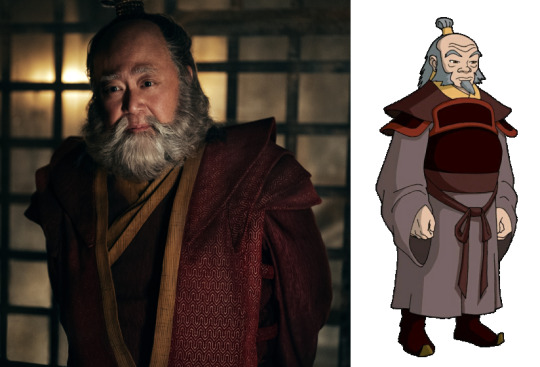
What I Liked
I know it’s not costume-related, but I have zero issues with Paul Sun-Hyung Lee as Iroh. It’s picture-perfect casting, as he’s about as close to a real-life Iroh as you can get.
Like with Ozai, the facial hair is spot-on. As I mentioned in the previous post, Asian facial hair tends to get bushier once the hair turns white. The makeup artists for this adaption did a good job of capturing this phenomenon.
I like the pattern on Iroh’s vest. It reminds me of the kind of interlocking, geometric designs you see on traditional Japanese fabrics.
The construction of the vest also feels very Japanese-inspired. Although less exaggerated, the pleated shoulders remind me of a kataginu, an over-vest that was traditionally worn by Japanese noblemen and samurai. It’s an appropriate inspiration for the Fire Nation royal with the most decorated military past.
I also appreciate how worn the trim on his robes look. Given that he’s been out at sea alongside his nephew for three years, it makes sense that even his finer clothing would look a little dingy.
What I Didn’t Care For
I wish the shoulders of his vest were a little broader and more dramatic, like the kataginu that inspired them. This is just a personal preference, but I think it would really hammer home Iroh’s past as former crown prince and accomplished general.
The red parts of his robe could be a bit dingier looking.
Overall, I would give Iroh’s live action look 9 teapots out of 10: Almost Perfect.
Surprisingly, I think I prefer this look over his Book 1 armor look. I’m a sucker for a good vest. Hopefully, we’ll see a few more Grade A designs from the Netflix adaption.
266 notes
·
View notes
Note
Imo there is not enough Valyria content out there so I would LOVE to see your thoughts/headcanons on what the geography, city, fashion, etc. looked like
okay this ones a little difficult because even though Valyria is clearly inspired by Rome, I don't like roman (aka greek) architecture for them it just doesn't really fit to me. Honestly its hard to assign any real life inspo because the existence of dragons would have had some major impact on the society as a whole, architecture included
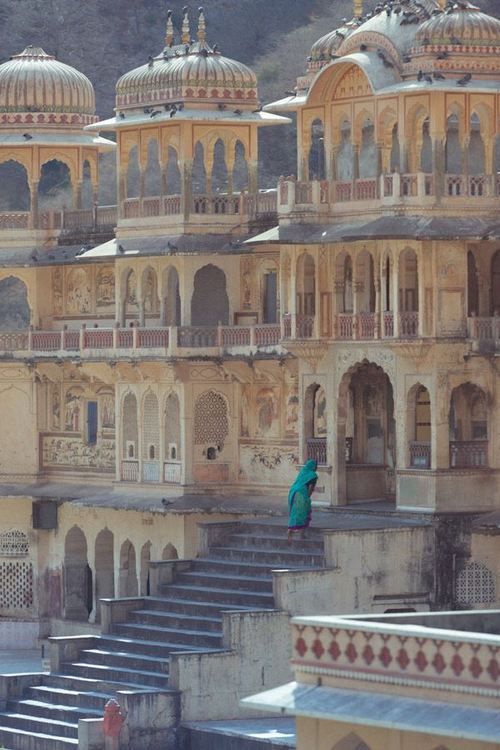




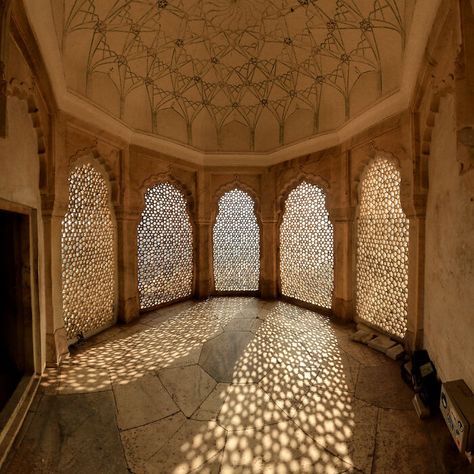
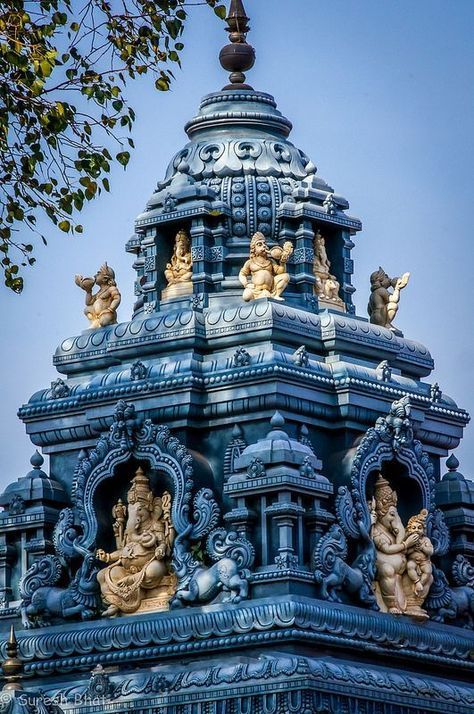

However, if I had to pick a type to ascribe to Old Valyria, my first choice would be a twist on Hindu architecture. I am absolutely obsessed with the sheer amount of details on the buildings (especially the Meenaskshi Temple at the bottom, everyone please go look at more pictures of it it's gorgeous). It's incredibly complex but also tends to be very symmetrical, the styles perfected over hundreds and hundreds of years. I also really love the idea of the spaces being open and well lit, it fits well.
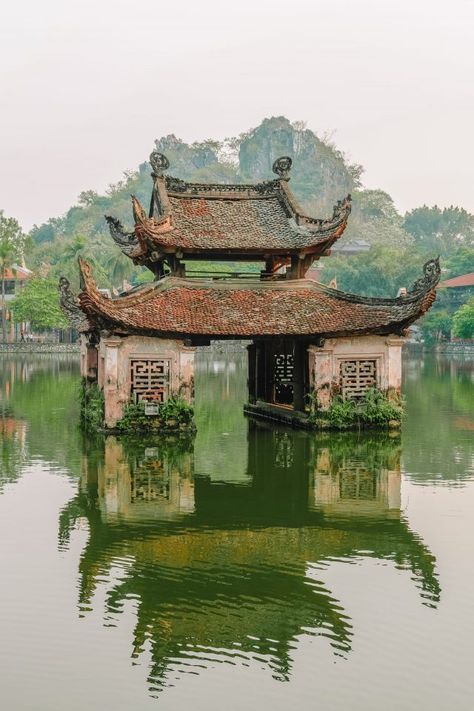
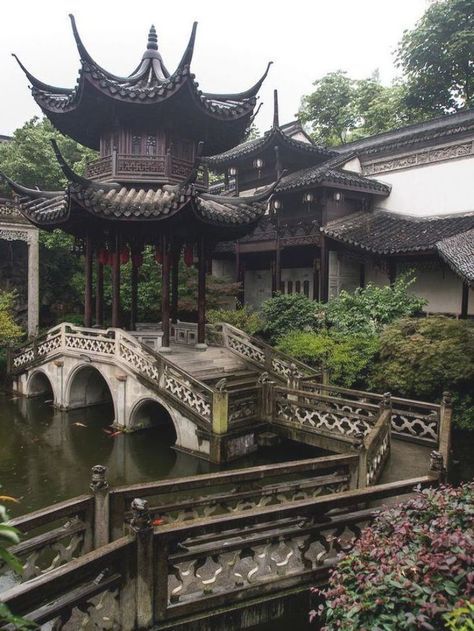
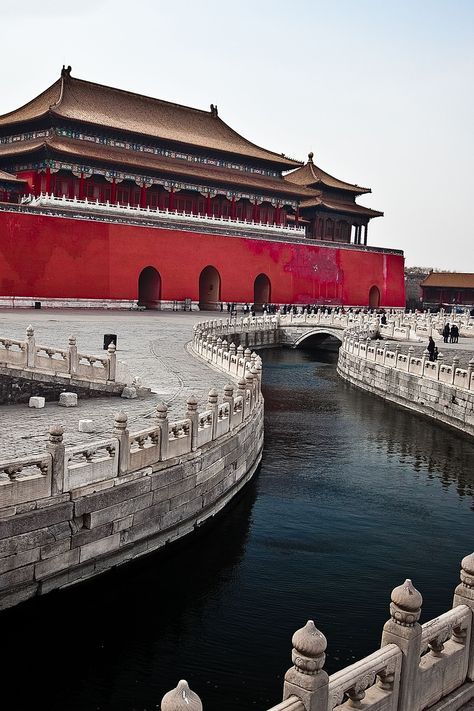



Another alternative is traditional Chinese architecture, with the added bonus of dragon motifs that are already there :D Another type of architecture with an intense focus on details, symmetry, and how the design of a space affects a person. Architecture is a reflection of where a society is in their development, and I find that this could be a good inspiration for Valyria, an advanced culture with the excess time and resources to build things like these.
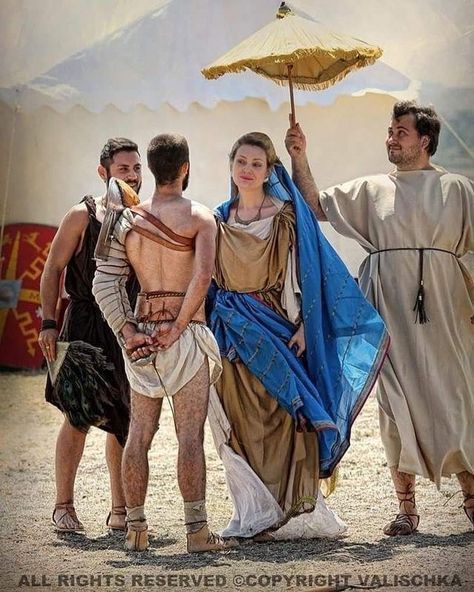
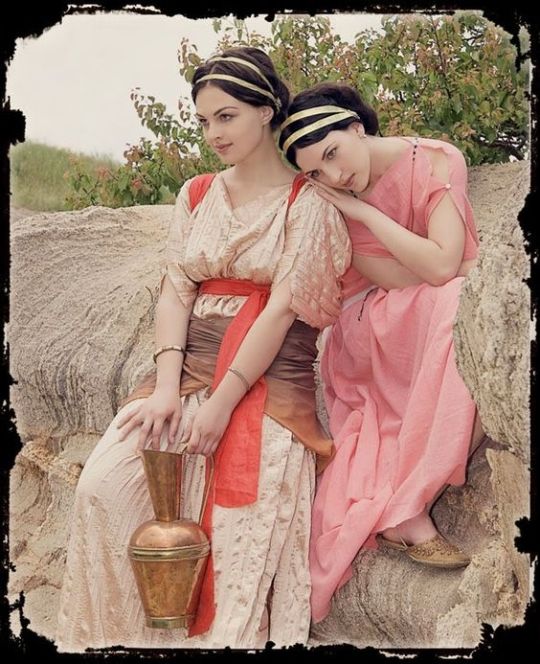
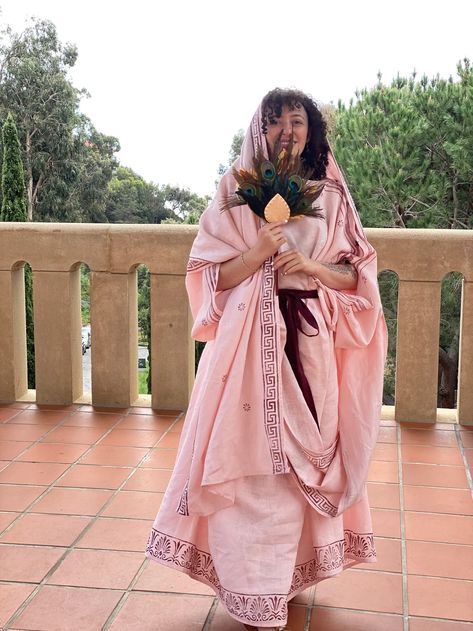


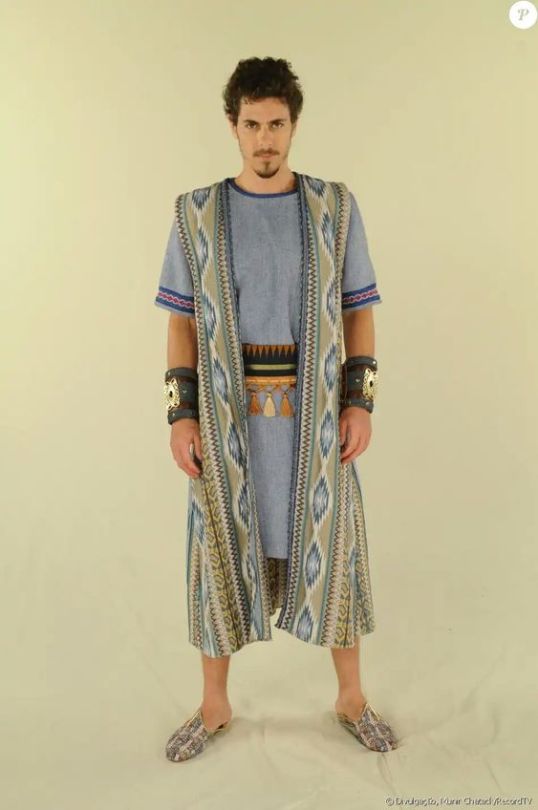
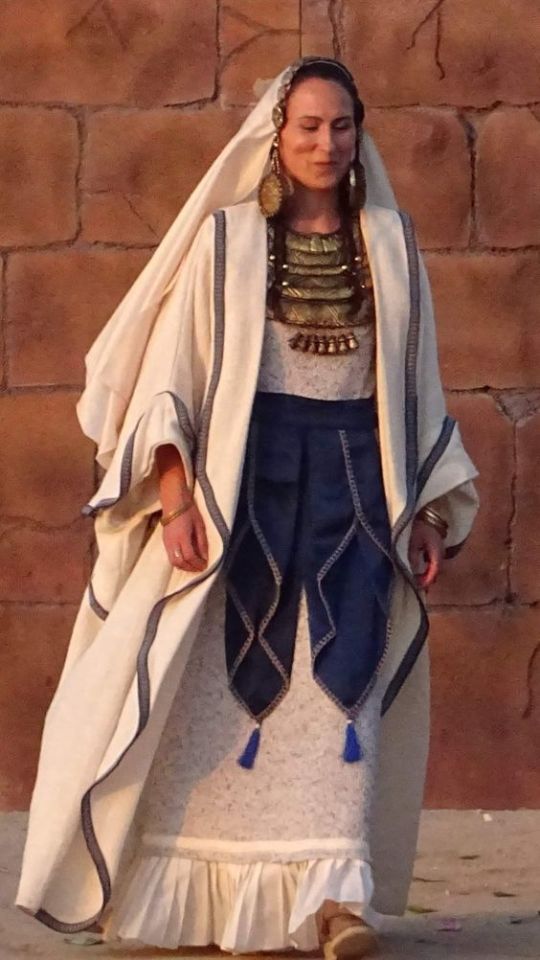
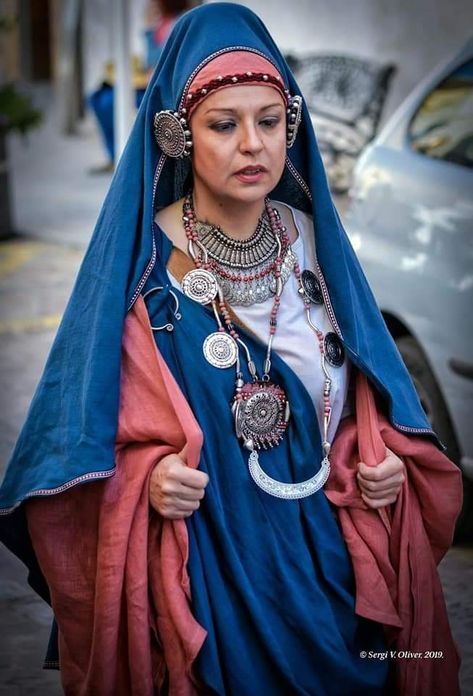
Woof okay clothing is all over the place I need to brainstorm and tighten my focus on different inspos (also I wish I could draw well so I can blend these styles properly but alas...anyways we ball). The main thing is mediterranean cultures I know that much. The Iberian Peninsula, Rome, Greece, the Minoans, Malta, Cyprus, etc etc all the ancient clothing and traditional costumes from around the Mediterranean Sea. Valyria was in a warmer, damper climate, meaning lots of loose fabric that could let air through but wouldn't weigh you down. Also doubling as shields from the sun. You get the gist I use this type of clothing all the time.
Okay Random Cultural Things Time
Art and literature? honestly really important because while yes this was a conquering civilization, they needed their exploits to live on in wall frescoes and written epics and dramatic pantomimes. I think they were literate, and probably spread written Valyrian to all the colonies, so that they were easily assimilated. People particularly fond of their dragons had pictures of them made and statues sculpted so that they would live on after their death.
Sports and entertainment also pretty big as well. Valyrians were a highly competitive people To Me so I think that riding, swimming, wrestling, racing, and other games were popular with the people, even those in the higher classes. Also fuck it I bet they raced their dragons. A really tall amphitheater where rich men lost money as they watched dragons circle around the ring. Or fight in midair, if the dragon riders were prisoners or sentenced to death.
As for religion, the Valyrians worshipped the gods that gave them dragons, but also tolerated the other faiths of the places the conquered, just in order to ease tensions (and because they had no dragons so why would they worship dragon gods). I like the idea of Roman household gods, with small altars in every home. Statues of the gods of the home, along with any gods a particular family might favor, along with ancestor veneration and dragon veneration. Dragon skulls and dragon masks on the walls baby!
#woah this was really long#spent my entire women and gender studies class doing this sorry Judith butler#asoiaf worldbuilding
66 notes
·
View notes
Text
vulcan fashion headcanons bc i have brain worms:
vulcan fashion is all about the breathable fabrics!!! i don't know if they have any animals that can produce a wool-like fabric, but i for one am all for bugs that can spin silks or fibers that act like linen. big ol' cave bugs!!! that produce silk that vulcans have traditionally collected and used to weave their fabric. bonus points if it's harmless to the bugs/environment.
while other species think vulcans must be baking in their traditional robes, their clothes are actually very lightweight and breathable.
vulcan fashion prioritizes coverage - long sleeves are traditional, as is some form of skirt or pants. head coverings are also popular amongst all genders due to the intense light of the sun.
while there are outfits for all occasions, vulcans don't usually go around in short sleeves or dresses. i like to imagine vulcans aren't a "prudish" people by any means, but there probably definitely is some logical side eye when they see someone with their epidermis out on their home world. what, do you want intense radiation burns?
while vulcan is a primarily desert world, there is a small amount of water - a little ocean. i imagine it might be a bit cooler on the shore and maybe a bit more humid? clothing there might be different than people who live in the desert based cities. more flowing fabric, an emphasis on catching the breezes that form off the ocean and while still protective, the fabric choices might aim for more sheer/lightweight texture than the desert peoples.
vulcans love beading! beading and embroidery of all kinds, especially on their formalwear. as a culture that prioritizes self control and logic, one might not think that vulcans would not be for self expression but they ARE. just like humans, they like a bit of sparkle. i imagine they're a bit more subtle in their choices, but they definitely enjoy aesthetic for it's own sake.
makeup originated as protection against the sun, but as vulcans have evolved, makeup is something all peoples enjoy. eyeliner, eyeshadows, all of it.
i imagine just as humans are drawn to the color red, vulcans are probably attuned to greens as well. maybe its a popular color, as well as cool tones in general? i can see a lot of "natural" colors being the primary choice such as sandy beiges or ochre shades, but green and blue are chosen as accents.
while many of the vulcans we see in the show have the oh so infamous bowl cut, i imagine short hair is actually quite common on vulcan. all genders rock short hair because it's easier to care for and can help keep one cool. but!! long hair is also an option, usually styled in intricate updos - lots of braids and loops of hair, lots of beautiful combs and tools used to keep long hair in place. all genders can decide to have long or short hair I DON'T CARE ABT CANON, THERE ARE MASC PRESENTING VULCANS WITH LONG HAIR TOO I WILL DIE ON THIS HILL!
while on the planet vulcans tend to adhere to their usual clothing styles, but with all of the cultural exchanges with humans and other species, they have adopted some trends. sunglasses for sure, as well as more colors and fabric types becoming popular. muslin, sheer fabrics, earth silks and brightly colored floral patterns! some of these things are considered "tacky" by older vulcans, but the younger generations love it.
102 notes
·
View notes
Text
Social Fabric; Clothing in a Free Society.
A Speculative Fiction Essay.
_
Amongst the anarchists, there are great collective lending libraries of clothes, and accompanying them are great collective laundries. Most clothes that are washed in the collective laundry are held communally, and can be selected from the whole on a basis that anyone can use them, but no one is allowed to destroy them.
Those who do not wish for a great variety of clothing will often go to the seamstresses and tailors and have constructed for them a few perfectly chosen items, or will select a few items from the whole which are close enough to be made over to their needs. Often, these choice items are of a form of traditional dress; those articles that have proven themselves under the wide test of history; kimonos, saris, chitons, the great plaid and shirt, shift and petticoats and stays with an over dress, the various robes of the various monks and nuns - although, there are some more recent designs which serve the function just as well, such as the common overdress. Many of these traditional and custom dressers have very few total articles of clothing, but also rarely share them. In a majority of these styles, there is an under layer that is easy to launder, and most individuals have 2 or 3 of these under layers, and launder only them frequently and often by hand or in smallbatch guilds, creating little strain on the great laundries of the clothing libraries.
With these two main ways of organizing one’s dress, the society manages to keep overall production rather low. Those who wish for variety hold their variety in common. Those who wish for more custom design tend to need little more in the sake of variety. In any case, the total number of clothing articles someone from either group may be using at any one moment is fairly comparable.
Those in society who are at the outlier of size and shape interact similarly to the rest, just in an expansive system of time. New articles of clothing are almost always brought into the fold because an individual cannot find something that suits their exact desires or needs, and there is nothing available which would be appropriate to make over and reshape for the wearer. Items are returned when they are no longer suited, and then they are kept in common till they are suited to another, or made over, or worn out. When one is very large, or needs medically assistive clothing, or is very tall, they have clothing made if there is none available. However, because there is less of a demand on these more specific articles of clothing, they are also worn out less, and take up relatively little in storage space. And so, the clothing of these outliers is also in the library system, just checked out less often- just as a specialized book might be. If something is so particular that after a few generations it still sees no use, it can be made over completely or scrapped for stuffing, and new items can be made for those who come along.
Due to the nature of bodily change; that we will grow, that we will shrink, that we will convert to new religions and reembrace old ones; that we will give life and be taken from it, there are always a fine number of perfectly crafted custom clothes being returned to the share houses and clothing libraries.
Having worked in the laundry, and having worked in the cotton fields and flax thrashery, and in the hunt or slaughter, and understanding of the limitations of production, those who make clothes take great care to make them to last. But that is not the only way that they ensure that their uses can be long in years and multitudinous in function. Clothing that is being made for general use is often made with removable panels to adjust the sizing, and over cloths are often pieced together and held by a great many laces, easily stripped stitches, or zippers. The sleeves are often designed such that many are in great bell shapes, with fastening cuffs that can adjust to a variety of sizes. Buttons and loops can be used to bunch or loose the large folds and plumes of fabric, or to hold them higher and short, which creates a vast array of looks and shapes and configurations of one garment. The same is true of many of the great skirts of the common overdress, which is designed to be floor length, but which can be easily folded and set to rest just past the crotch in a great petticoated cone; or nearly any length in between. These adaptations, along with the lacable panels on the bodice, mean that these dresses can sometimes be worn from child to elder in many configurations, sometimes even by the same individual across a lifetime.
The lower total articles needed by the society, and the immense length of time that many articles stay in circulation, means that garment workers can take much more time for the planning, drafting, patterning, and stitching of each garment. To assist them with this task are the vast collections of patterns, tucked away by generations of previous stitchers, and curated by the many librarians, historians, researchers, and other everyday individuals who take their interests there. There are also a great many people in the society who seek something to fill their minds and their hands, and whom are willing and eager to assist with the hand sewing and embroidery and button hole stitching; but not everything is done by hand. Where it is of no sacrifice to the garment's quality, mechanical means of stitching, riveting, and weaving are used. Those within the society are not against such machinery; they are only against its application for the sheer purpose of speed when speed is not warranted, or the purpose of abundance when clothes already abound. In this society, it is seen as the duty of everyone, the most sacred duty, to use resources in the best ways possible. To intentionally make an easily-exhausted garment is seen as a great disrespect to the cotton, linin, wool, or hide that gave itself for the production, and it is seen as a great disrespect to the others who helped harvest it, weave or tan it, stitch it, store it, and wear it.
The clothes are maintained with regularity, often by each wearer, and also by those who take their work at the laundry. At the great communal undertakings, such as a large harvest or construction, it is not uncommon to see groups take long lunches and darn each other's nipped clothes. In the community houses and eateries, there are also a great many people whose fidgeting hands turn just as gladly to mending as to creating. Objects being moved from one repository to the next are often passed along with people on the rail lines - and often, they reach the new destination having been embellished, cherished, and turned over several times by several hands looking to find where they are weary.
There are many regional variations in dress that develop to suit the climate and culture of the wearer. However, the overlays of climate and culture tend to be rather expansive and slow, not reaching sudden shifts upon some border. And so interchange between the local systems of depositories takes place in overlocking regional scales, with each library of clothing taking its exchange and refreshment from those nearby. The microcommunities of regular laundering and stitching and curating in any area tend to have some overlay with one another, and that overlay allows them to contact one another to ask for specific patterns, fabrics, skill sets, or garments to be shared or exchanged or gifted.
All members of the society participate in the production of attire, as the production of attire is a result of all the interlocking elements of the society itself. Urine collection assists in the processing of wool and leather. Leather and wools themselves are a byproduct of ecosystem management tactics. Sheep eat away at invasive and aggressive plants, and they form a coat to keep themselves warm. They do not shed the coat of their own accord, and those who assist them are left with the need to dispose of it. Not wanting to be wasteful, they turn it towards the purpose of fabric. The textile it makes is incredibly useful; it is warm when wet, it is water resistant, it can hold its shape, or it can be felted into new ones.
This is the general principle of the anarchist’s, that all society is in process, and that the meeting of one need is always in process of the meeting of others. Interlocking systems, in which each individual does what is most helpful for the least effort given their personal and social circumstances, and in which the whole of the society takes on together that work which no one likes to do very much, leads to little begrudging in labor. And the complementary design of the ever changing social systems leads to new innovations being constantly added into the system. The ecological project of invasive species removal leaves a grand number of seeds which cannot be planted; and so the largest are turned over by jewelers as beads, and rendered sterile, whereas others are pressed as dyes, or sterilized as coat stuffing. Many other parts of this flora rendered into cordage or fiber, assisting in making the body of clothes that can be selected for different purposes, but also in the weaving of baskets, which aid in the transport of many things besides the clothes themselves.
Overall, the relationship to clothing amongst the anarchists is their relationship to a great many things. It is complex, as the needs and desires of the community are complex. It is seen at scale, as the management of resources must always be done. Each individual playing their part, the day to day small scale of weaving, wearing, washing, and darning; and the social organism as a whole managing the long term store and circulation. And even then, the social organism and the individual being on the same continuum of self, each covers where the other cannot.
Basic mending skills -in relationality and in fabric- are acquired by most through mentorship, sometimes with relatives, but most often mentorships develop out of the simple connection between one who knows and one who will come to know. The communal holding of labor creates a great many opportunities to ask questions of artisan crafters, and the slow nature of production, and the abundance of skilled crafters, lends to no shortage of time for education. These mentorships often create lifelong structures of support and kinship, and can serve as a primary social means for transference and norm setting, but not all are so long term. Some last but just a single moment, in a single stitch. The informality and overlapping of the mentorship structure leads to many students and many teachers, and often one is a student of one craft and a teacher in another, reversing the roles of knowledge giver and receiver, flattening the power between. And when that is not enough to flatten the hierarchy of knowledge, the simple giving of knowledge over time, and the gathering of one’s own skill, brings the mentor and the student together in talent and regard. If one teacher is a jealous guard of their hardwon tradeskills, the student simply moves on and learns from another, or watches and interprets the actions to recreate them.
Those who are less socially skilled, or who find themselves no compatible mentor, or simply desire extra or specific training, often attend lectures and workshops and such that are arranged by other crafters. Often, these workshops are organized out of a sheer exuberance with one's work, an utter yearning to share information about it. Occasionally however, some person or group will ask of someone to share in an open setting, and this is rarely refused.
There are of course a great many people who participate little to none in the direct social production of clothing, but whose very existence, and whose feedback and desires, inform the trends and advancement of production. There are those with little use of their hands, or an inability to learn motor skills, for whom laundering and stitching and patterning are most often out of reach. The abundance of high quality garments, seamsters of all skill levels, and the length of time in which clothes can remain all lead to their being plenty extra to go around. In fact, it is in designing assistive clothing for these individuals that many crafters take their finest joys, and sharpen their design skills towards greater invention. In building a dress suited for all seasons, not abrasive to the skin, and which can be put on and adjusted with the use of only one finger, for instance, even the greatest crafters must return to thoughtfulness, experimentation, and research. For this reason, those circles of high craft and artisanry spend many meetings and byside conversations discussing the nuances of clothing the disabled. Disabled people themselves, especially those who cannot participate in social clothing, often host the most widely attended lectures and roundtables within the halls of the great laundries and pattern libraries.
Babies also do very little to participate in laundering or stitching, except occasionally bring smiles to the eyes of those doing such work.. And yet it is the babies' clothes that wear out the fastest. They often do not notice the holes to be darned, nor do they ask others to darn them. They take no care when catching the nape of their jumper on a twig, and move blithely forward regardless of the damage. Their exemplary quick growth often means things are quickly returned to the library of attire. However, babies rarely suggest new designs, or give clear and concise feedback on flaws or opportunities, and they almost never order custom designs. This is all of little concern to the stitcher, in spite of it all. Babies' clothes are easy to make, famously small, and can be incredibly entertaining. A swaddling cloth designed to look like a fish becomes, when worn, a stunning image of a baby being eaten by a fish. When the baby is sad, the baby looks sad about being eaten by this fish, and this is heart wrenching and sympathy driving. If the baby is happy, the baby looks happy to be eaten by the fish, and this is silly and jovial. In this way, design can be used to help assure appropriate reactions to the baby's behavior, ensuring socialization and emotional coregulation. The babies being dressed very funny also serves as a good impetus to look at them with regularity and rigor, forming one line of care in the overlapping fabric of child rearing. For all of these reasons, it is not uncommon for the tired milliner to lay down their dress form, and take a restful opportunity to stitch some baby clothes. There are a great many festivals and art fairs in which baby clothes are shown as fun and enriching representations of the collective’s ability. The novelty also rarely wears away, as babies grow so quickly and baby clothes are exchanged so widely that one is always seeing new babies in new fun fits, doing new silly things.
Still, though, the novelty and sweetness of a babe does little to assuage the dread of laundering the baby's diapers. There are a few in the society, however, who don’t quite mind the smell, or who cannot smell it at all. They cannot alone handle the masses of baby breech clothes, but as everyone does what is most helpful for the least effort, there's a lot of effort left over for the more difficult and undesirable tasks. When each knows it has been done for them, and -should things go well enough into age- will be again, it is not hard for most to swallow their pride. But still, some cannot handle it, and turn themselves to other unloved tasks to take their share in the whole.
The menstrual pads and rags and cups are much less challenging, as most can be rinsed or boiled and then washed aside the rest. The blooded water is often boiled down for meal, to be used in the fertilization of soils, just as the wastewater of the babies and the incontinent are processed into the greater waste treatment for ecological return. All things, even the least desirable things, are revitalized to make part of a complete system. The laundering can circle back to the growing of the very fibers from which the laundry came, making them thrive alongside their niche neighbors and other biologic users, such as the butterflies and flowers and vines that form the very dyes that are then represented again in the clothes embroidery and patterns.
There are, of course, some items of particular sizing and customization which must reliably be returned to each individual for whom they were made, until such time that they are no longer of direct use to them. The low sorting pressure applied from the communality within other aspects of the laundry system leaves this a much less daunting task. Those working in the laundries do not have to return each item to its preferred wearer; infact, relatively few and relatively small items are returned. Injury preventing daily support items like bras and corsets, and medical assistive items like splints and braces, take the first priority in both washing and in sorting. Many of these items are also designed to need fairly irregular washing, but the labor required to make them, and the changing nature of the body, often means that wearers rarely have multiples that suit their exact specifications. In this case, the library laundries also keep on hand more general purpose items that perform the same functions, if not quite as specifically. General adjustable braces, a selection of corsets that previous users have given over to the system, a variety of wrap bras, compression bras, and retired bras all serve the intermediate function whenever a custom item is in the wash, awaiting repair, or under construction. The sorting of other items is not unavailable, just rarely used. The most common requesters for this are those who wear underdresses and undershirts, and these being relatively easy items to launder and to sort, this request is most often obliged by simply placing a hold on the item in question. However, something given over to the larger system always has some risk of being missorted, or mistakenly checked out to another, and this is understood by those who choose to handover such important items for general laundering. Hand laundering or small batch laundering are often tactics used to mitigate sorting pressure and ensure diligent return.
Small batch laundering forms a layer of communal organization and laborsharing that is far more personal, and used for more personal items. Crotched underwear is one item for which many wearers have their own personal or near-personal supply. Except in the coldest of environments, these items are rather small, and not difficult to hand wash or small batch launder. These items are often shared between small groups of friends, family, or partners, but just as often held individually. Within the larger laundry system, there are often undergarment guilds which co wash and sort together. This smaller scale tends to provide more comfort and ease than sharing such personal items with a whole library's worth of users, but also helps benefit from the pooling of labor. Still though, there are those who hold these garments in full commons, taking from the library whatever will fit their body and their use, and returning it with no desire for privacy. It is the nesting of larger scale and smaller scale systems that makes the meeting of all of these seemingly conflicting needs simultaneously possible.
There are also some for whom crotched underwear is rarely worn, such as those who primarily wear skirts and underskirts, or shifts or other underdresses, and they often hand launder out of a sense of ease. A couple shifts can take only a moment to rinse, and are often set in soapy bathwater, then rinsed in clean water, then hung to dry. This process fits so neatly within the routine of many wearers that it forms almost no extra labor. However, any particular stains or longwear smells are often requiring of a more specialized removal, and so shifts are then sent to the laundries. This rare return makes individualized sorting somewhat unnecessary. In the great rooms and halls and closets of the libraries, there are sections for different categories of items. One room or wall may be devoted to underdresses, with each section sorted by color, then circumference of the garment's fabric at its waist point, and then from shortest to longest. The measurements of each are typically then sewn in tags to the outer hem. This creates an ease for those seeking to find something in their particular size and use, often such ease that one can find the exact item they left to be laundered just days before. One can even send a message ahead to hold an item, and each item’s tag has a unique identifier. Occasionally these are barcodes, but most libraries have their own systems of identification tagging. The selection of underdresses may be large, but the selection which meets one's needed measurements is often concentrated to a few racks per type of clothing item. In this way, very little time is needed to actually find desired items, especially considering most members in any given community have worked at least a few hours stocking their library’s shelves and becoming familiar with its methods and its collections.
Perhaps the most abundant particular clothing item is socks. In appropriate climates, many individuals wear sandals and slides much of the year, but even so, socks add that extra layer of friction and size adjustment which allows for wear during even hard labor. The greatest extent of clothing mechanization takes place in the weaving of these thinner, warm weather socks. These wear out extremely quickly. A pair of thin socks may only last the dedicated wearer 5 or 10 years, and then, that is with less than weekly wear. Those socks held communally often last even less time, being worn near daily, and get worn out in about a year. The society does have an ethos of repair; however, these items being so thin, and also so easy to produce, they are one of very few items in the society where repair is less sensical than disposal. This quick disposal does form an abundance of easy rags. The society does also have purpose made rags, often those made of old clothes converted to new lives, but the socks fill a different role, especially in cleaning those things that are rather unpleasant. It is no great loss if they are sent to an early life in the compost, but many are used and reused as rags for longer than they ever survived in their intended purpose, as is with many things. The abundance does also lead to them being seen as wonderful test items and craft supplies. A learner trying out a new stitch may use an old sock, and worry less about ruining it and more about learning. This allows breathing room for mistakes within a society where the proper use of resources is the most prized social virtue. These socks are often embroidered with strange frills, and are taken with the others and made into craft items. Dolls of sock are a common children's craft. Sock coats and capes are a pleasant and fashionable adornment, especially for the many festivals, which themselves are lined with sock garlands.
The abundance of socks, however, does not speak to a great uniformity of them. Many cuts, shapes, sizes, thicknesses, and materials are used. For the purpose of laundering, socks are separated from the rest of the clothes, and then themselves are split into batches by cut. From there, they are sorted by size. Different localities have their own standardizations of sock sizing and therefor their own sorting methods. One of the most common methods is that socks of a certain size have a certain number of horizontal lines across the toe. This method makes machine storting and hand sorting both fairly simple and reliable, as well as adding little extra to production. It does sometimes clash with other intended designs of the sock, however, and so is not universal. The interchange of people can also occasionally cause socks of one standard to enter into a sorting system of another standard. These tend to be placed in their own sections at the clothing library, and those who wish for a little more variety in their life often spend time digging through these to find the most different and unique examples, often saving them as personal items to hand launder. Most of the rest, though, are sorted by system type, and, if feasible, used as packing material when a shipment is made to a nearby area that uses that system. If there is no shipment to be made, or if there is more relevant and needed resources to be sent as packing material, then the socks are simply retired early. Even a near wasteless system must balance between reuse, return, and efficacious material and energy management. In such a case, having a few select categories of items which are generally exhaustible and low priority can free up the system to more easily prioritize everything else.
The rest of the worn out clothes are not treated with such abandon as the humble summer sock. The respect of the labor put into them creates little incentive to waste. Trimmings and leavings, the cabbage of the patternmaker, is used to stuff sleeping pillows and mattresses or coats, still being of high quality and not inundated with allergens. Old clothes worn to thinness find new homes in the cookeries and kitchens, assisting in the straining of broths and cheeses, or as the cover of steaming vegetables. The leftovers of cloth, after spending many years in their function with the body, can continue to serve for even longer after. The stuffing of seating, the control of erosion, the wrapping of fruit trees in a harsh winter, lining, all are beloved uses of the clothes of a great granfparent's generation. Work clothes are drawn from those items who are close to being put to these purposes, but whom still hold some rigor. Those tasks which may be most compromising to the cloth are often done in near dressup, emulating the visages of the past. This occasionally leads to rips and tears in the clothing, but it is seen as no great waste, and in the lack of worry, laborers are able to take joy and laughter in the mild embarrassment of a crotch seam bust open. Otherwise, many of those fabrics which are beautiful -but well worn- are turned towards quilting, or used as patches. This creates a fine degree of adornment and expression, with those who do keep personal garments being able to customize to the extreme, and with those socially held garments each having their unique quirks and flourishes.
It is the entropic nature of things to decay, and decay does reach the usufrutuctian society. However, this decay is made use of, slowed, understood, and worked with. Each moment where material reality causes a breakdown in the system becomes an adaptation within the system, increasing complexity and diversity, preparing for the next breakdown, and innovating for new uses. Moments of waste are turned over to become the foundation of other systems, or to be used as input. The very waste of death; that we may die and leave behind that vessel which has made us, is undone in its revamping towards use. The body is processed, with that which is meat serving the ecological role in carnivore rehabilitation, or in feeding those animal domestics which require it. The skin is turned over to leather, often making up shoes, or strong gloves. The same is done with those animals which must be harvested, either for the purpose of ecological management, medicine, materials harvest, research, or cultural use. Those items which would be contaminated if made from one another are made from the other living things; bog tanned hide and organ bags for food and water storage being the most common need. The usufructians do not harvest from animals what they will not harvest from their own dead, feeling no justification in holding only one species’ life sacred. Still, however, the human body does not provide for all services, and the death of animals is inherent to ecological systems. Some, not wishing to take life, utilize glass for drinking and food storage purposes, and avoid all leather whenever possible. But those who can not bear such heavy material,, often require the use of the more light and durable animal derived bags and wraps. These items are treated with even greater care than the fabrics. It is not uncommon that when one sees people sitting down to eat on the sides of the lush walkways, one will notice them spending more time looking over their packing materials than actually eating from them.
The use of animal products, human and otherwise, is treated with both graciousness and solemnity. A great deal of meditations and spiritual practices revolve in part around this posthumous use of the body. Usufructian funeral services are varied, with hundreds or thousands of regional, cultural, individual, and religious options to discern between; but even so, a great majority of them speak of the return. Not all return their body through leather and fed flesh; a great many are composted, returning to the soil which fed them. Some are burned in the great forest fires that bring the flowers. Bones are turned to field powder. All things that come from return to. From ashes to ashes, from life to life, from body to body, from soil to soil, from all to all; to be a usufructian is to eternal only borrow, to never completely own. The anarchist takes what they need, and gives to their ability; and in death, there is alway the last giving.
A central premise of anarchist philosophy is “From Each Their Ability, To Each Their Need”. In the world of the anarchists, the near complete overlap of hobby and labor, alongside complementary labor facilitation systems, social principles of nondestruction, and production paced to an abundant sustenance allows for this to be accomplished. “We who waste not want nothing. We who do not destroy are never led to destruction. We who meet needs are met in abundance,” goes the song the launderers sing to pass the time.
Amongst the usufructians, most beloved is the social relationship.This is the relationship of the individuals to one another, the individual to the society, the society to the ecology, and so on. The social relationship is, in essence, the whole relationality between all parts of reality, interconnected, caring and providing for each other. In this regard, all are cared for and all are accounted for. One who allows their clothes to tatter unmended will be doted upon by the community, offered a great deal of help in repairing them, and in stabilizing whatever aspects of their life must be out of order for such a tragedy to occur. One who does not maintain their leather storage wraps will be repeatedly brought food in glass containers, with many people offering to bring them food each meal, up to their mouths if needed, and to take the storage items to be cleaned afterwards. This is done with a special caution against condescension, and the work is passed amongst the abled participatory community as to not fatigue one anothers compassion. In this way, neglect is managed by understanding that it comes from a place of inability. Those few who are able, but unwilling, often find the hassle of being cared for more exhausting than caring for themselves, and tend to begin maintaining their resources once again. Unable and unwilling is rarely the case however. Most neglect comes from an inability in other respects, throwing one off of balance and out of systemic living. Those who are in greater need are offered care, and offered it with regularity and without shame. This care is like water, and sinks to the low places in them, filling them up, rendering them unneeding; needs continuously being met.
There are occasionally those who seek to accumulate, not wishing to return their clothes. This is often met without issue. A few hoarded items by a few people is not enough to break such an abundant and cared for system, and most of these individuals return their hordes eventually, after community support and care drives them to unlearn their anxieties of scarcity or fear of noncontrol. However, occasionally, one or a few people will attempt to checkout a great sum of the most desired and necessary clothing, setting themselves up as lords of such a resource, and demanding that others give to their whim in order to attain things. In the many upstartist attempts of this nature, this is thwarted simply by those users of a library going to another library for whatever items are now locally scarce. Those whom have such hoarded abundance are then denied the access to remove further items of the type they took, and are given only standards that meet whatever real gap in need they have. Eventually, their whims not being sated, and their laundering now needing to be done individually, they almost always end up returning the clothes to a laundry, and quietly returning to society as though nothing had happened. In those few cases where individuals hold out for their entire lives, the clothes are simply reclaimed upon their death. In rare instances, some small familial groups have established long lineages of holding on to hoards of checked out clothes. However, much of what they know is the library model, and seeing its practicalities, they often emulate its customs and systems. Having no input aside from their own craft, they care for the clothes just as diligently. Within a few generations, they become indistinguishable from the collective laundries and libraries around them, and begin to slowly open exchange and public services. These more isolated library systems do tend to create new systems and innovations in storage, sewing, distribution, and laundering, so, in this way, those who dissent become great contributors to library society. On the scale of time, their return is as blessed as any return to the collective while.
The same principle is applied to any area within the whole that does not seem to be in alignment with the usufructian values. There are those materials that seem more time or labor intensive than their fibers or substance could possibly be worth. However, to a utopian, one who views all society on the great scale of the fullness of time, it is known that ease comes through careful work, not through abandon. The ecologist knows that it is complementarous diversity which brings ecosystemic tranquility. The anarchist knows that it is noncontrolling complexity, each acting in their best towards a shared future, that drives all of reality into collaboration. Each being all three, they clothe themselves not just in the simplest of fibers, which are easiest to mechanize, have the most history and example, and are most comfortable. With such a great portion of labor assuaged, and such a great portion of discomfort brought low, these people find themselves with extra tolerance to bare labor, and extra tolerance to bare discomforts, and they measure these tolerances out and find ways to use them towards the greater social good, and the greater good of themselves. If there is a great waste in hickory nut shells, for instance, one may practice methods of grinding them down into a fine powder, and pressing them with adhesive to form the shape of a sandal. This is not ideal for daily wear. It is too hard and uncomfortable. But the wearer finds themselves building familiarity with the material, seeing where it chips and what surfaces it is assistive to walk on. This process is intended to be personalizing and generative. Even if hickory nut shells never become a meaningfully useful clothing material, their temporary adoption as such allows individuals to build a relationship with them as a material, and explore what they could be used for. All things and all people have their place in the society; so long as careful attention is given, with understanding of needs, through personalization and diversification of the relationships that are had with them.
The society is not, however, in any lack of materials. There are a great many fibers grown in the great many biomes, and much of global dispersement of goods is in textiles, used as packing inbetween medical components and other fragile specialities, and bedding in the rooms of travelers. The great diversity of communities - and the uniqueness of each bioregion- leads to a multitude of fabric fibers, an abundance of processing methods for each, and then still a great many more use cases constantly being developed and discarded and elaborated upon. The many cotton species in the world are referenced in guides for their strengths and weaknesses and sourcing and abundance. Yucca, nettle, wool, cashmere, linin, seagrass, straw, mulberry bark cloth, jusi, silk, river cane, and hundreds more are grown in mixed ecological systems around the world, mostly in their places of origin or long term cultivation. This variety means that crop failure, blight, or other disruptions in one area do little to depress the collective supply of textiles.
To avoid species invasiveness, new crops are introduced slowly and carefully into the ecology of desired regions. The primary focus of new introductions is to provide redundancy in local and regional food systems, ensuring that all nutrients are available in multiple forms at every time of year, preempting crop failures, and ensuring that allergies and other health conditions can be easily dietarily accounted for. However, the longscale nature of society, and the ability to selectively breed native crops towards different seasonality, nutrition, and shelf ripening, often mean that there is little desire to import new food crops. Many ecological maintenance systems are built to expect new species introduction every generation or so (with some more fragile ecosystems being on much longer time scales). While crops suiting some ecological niche besides food are also often needed, such as to hybridize a beloved blighted local species, there still, on the grand scale of time, comes moments where the opportunity to naturalize a new species for the explicit purpose of human use and human joy arises. In these moments, new base fibers for textiles are considered by the sortion selected councils and ecological research syndics, and occasionally are selected.
The clothing arts, being widely shared and thoroughly understood practices - weaving, stitching, drafting, patterning, grommeting, buttonholing, thrashing, and all the rest - all help form the shared cultural motifs by which metaphor, aphorism, and wisdom can be drawn. Young lovers first separating compare themselves often to the grommetted panels of the common overdress; coming apart, fitting together, finding their way into new patterns that suit the body. To unfold one's skirts can mean to be growing, or otherwise, to be seeking more warmth, both emotionally and practically. Similarly, to raise one’s skirt often means one is preparing for hard work, acting unencumbered and uninhibited; tho sometimes it can take on other, more sensual meaning. In the great stories of the many peoples, one often finds motifs of dress demarcating the overall plot of the story, giving character insight, or implying new layers of rich meaning. This shared understanding of material culture is often generative in individuals' attempts to further interpret their own experiences, and in the describing and shaping of relationality between one another.
In this metaphorical approach, it is said that all reality is the fabric resulting from the tension of the threads of dialectical synthesis; overlapping and informing and supporting one another. Physics is the loom. Society wears the fabric. Individual consciousness is the act of looking in the mirror. Social consciousness is the act of looking over the fabric to see how it is made, and to understand its construction. To darn is to reform. Revolution is the act of changing the drape of the fabric, often requiring the ripping of many seams, experimentation, and many practiced and skilled hands to sew it up right.
The richness of metaphors that arise from such a multi-skilled population is a driving force for innovation and communication. Familiarity with the methods of weaving allows for consistent innovation in data storage, requiring less and less resources to store more and more information, which further feeds back into the accessibility of reference material for further garment drafting. The fine motions of needlework teach movements of the hand that carry forwards into music, facilitating unique styles of plucked tremolos, allowing those so inclined to play and bring joy to the laundries with their sweet songs. Experimentation in waterproofing outerwear and soft shoes has led to the invention of canvas boats, as well as patches that can be applied to fix leaks, further assisting in the safe and ecologically sound transport of materials.
All aspects of the society overlap to form a cohesive and coherent whole. Each process is entangled with one another. The waste from one becomes the bedrock of another. Each skill learned in the pursuit of a task is then applied to the next task, and each lesson learned in the specific is then analogically applied to the general.
The society is clothed together in the great cloth of interdependence, woven in the ten thousand strands formed by the tensions of material life. It does not come to pass without thought, or planning, or intention; just as a length of flax left loose will tangle. But together, each giving and using, but none destroying, all are cool in summer, warm in winter, and cozy all year round.
#anarchism#rose baker#text post#clothing#historical costuming#utopia#library socialism#speculative fiction#anarchy#leftism#socialism#library of things#usufruct#social ecology
54 notes
·
View notes
Text
icewing redesign and headcanons!!
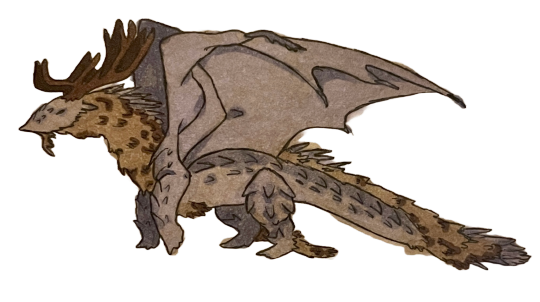
this is kind of a jumble sooooo
physical traits
i think they are so huge. easily the biggest out of all the tribes on average
huge not just in height but they also tend to be chubby and fat like blubber
furred at hatching, but can lose fur as they age, often ending up with partial fur (mane, down the spine, trailing at ankles, etc)
also perhaps “beards” (genderless, duh)
(my imagination for this is kind of traditional unicorn esque, like those fuckass tails + hair around their feet and their mane. yeah)
speaking of fur,,, they have little toe pads with fur sticking out between their toes!
tiny little baby ears to prevent frostbite
antlers instead of horns!! or at least horns with many branches like antlers
kind of smallish wings compared to their body size, so they tend to be slowish, lumbering fliers but they still get the job done
this “style” of flying lets them be very sturdy despite high arctic winds
icewings hunt underwater, so they’re somewhat partially aquatic and can hold their breath for long periods of time (also hence the blubber)
their “spines” aren’t spines connected to their skeletal structure, but quills connected to their skin, so they fall out and regrow a lot, and also get embedded in opponents skin during battle
colors,,, im always conflicted on. for sure natural arctic animal colors (all greys, whites, beiges, yellows and browns during summer months) but also like. fuck it they’re dragons so blues, purples, and pinks too

i don’t remember when i originally did this, but i gave them a pronounced throat sac thing to produce sound and music? so yeah. we’re sticking with that because ive been drawing it for like a year
on the topic of their throat sac! i love to imagine what the tribes individual voices/languages sound like. i think icewings are very veryyyy scary according to other tribes, with deep growling, warbling, and clicking (like a leopard seal). and really throaty hoots and high pitched screeches like a snowy owl!
just saw a video of a caribou (?) fucking screeching. so yknow what icewings do that too (but not in normal communication it’s explicitly like an “uh oh!” noise)
frostscales! and also frostless. warmscales? i don’t really know but they exist to me. they’re kind of a lot less,, harmful than firescales, especially when kept within the ice queendom, because they just add more ice to existing ice
culture!!
so even though snowfall broke down the physical tracking of the circles, that hierarchy persists and there is for sure a hierarchy of dragons with closer relationship to the queen etc
now it’s just less concrete so it’s easier to move up and down etc
i wouldn’t think it matters any less though, like social standings persist
i think the social climate within the castle is insanely different to what it is outside the castle
inside the castle: cold, cutthroat, fuck you
outside the castle and outside the circle: living in a really harsh environment, so an insanely strong sense of community and togetherness, still with distinct familial groups, and icewings probably have one of the more common rates of monogamy/marriage
formal school settings depend on the town, some towns have them,and these towns also tend to be more formal in general and carry more remnants of the circle system
what’s more common is apprenticeships
speaking of apprenticeships,, jobs
hunting is taken on as a community activity, and there isn’t much to grow so there’s not a lot of agriculture
but there ARE a lot of traders/merchants in the border villages
also a lot of icewings who focus on hide/leather preservation, clothing and fabrics, sculptures,, lots of artisan work
lots of holidays, like holidays allll the time (high stress environment creates a need for frequent relaxation)
just for shits and giggles,,,,, some examples
celebration of first snow melt
celebration of first flower buds
midsummer celebration
summer ending celebration (heralding in a kind winter)
probably during the winter a celebration every biggest full moon or something
you get the idea
i forget if this was confirmed at some point in the books, but i think “royal” instruments are just straight up like woodwinds carved from ice. so they’re royal because they can’t leave the tippy toppy coldest place of the continent otherwise they’ll melt
i think there’s a lot of legends related to like dragons trapped beneath the ice and lost in snow storms etc, just because water beneath ice makes some crazy terrifying sounds
as for population distribution, i think icewings are kind of concentrated at the castle, and then closer to the sandwing border. the tundra is kind of just meant to be traversed rather than lived in
they’re very friendly with sandwings and seawings! also eventually friendly with mudwings because of crystal, and probably at least somewhat friendly with skywings as well
although they did have a history of fighting with skywings for the northern mountain territories, they’ve come to an agreement now
also, of all the pyrrhian tribes, they’re one of the most friendly w the pantalan tribes since the icewing queendom is the hub for travel
fashion!!
so there’s a lot of mixtures with sandwing culture! drums and woodwinds, shawls are popular, beads braided into manes and tails
furs and leathers are common (using all parts of the animals they hunt) and carvings made from ivory are also common art + jewelry
i think other jewelry would consist of like really thin strands of metal looped around their face and antlers (so inconvenient but so pretty)
royal vs commoner
wow these categories are getting,,,, messy. sorry!!
royals have really political weddings still, related to rising in the circle ratings and whatnot (lowkey so much incest within the castle,,, save them)
it’s getting better, and dragons are marrying outside the nobles but still
monogamy would be commonly practiced but i don’t think they’d hold the “nuclear” family model i think all generations would help raise the hatchlings and instill family values into them or whatever
i think it’s similar for commoners, with generational but not communal raising, but obviously marriage is isn’t as pressured, so it’s less common
i generally think marriage isn’t the norm amongst dragons even if a couple is monogamous
as for commoners' view on royals,,,,, very very icy and unkind. royals tend to be really only concerned with royals.
i think they’re so unconcerned, actually, that there’s a whole separate “cabinet of diplomats” setup that live closer to the sandwing border and handle all the dealings with the other tribes. they send a report to the queen every first moon cycle. fucking maybe
royals and nobles tend to have more fun/thick and long fur because fur is really hard to maintain, keep healthy, and keep clean so a royal with a lot of clean and beautiful fur is a really clear sign that they put a lot of effort into their look
versus most dragons don't have the time for that, so over time they’ve lost fur (not completely)
religions/superstitions
i think they’re insanely superstitious!!
the amount of ermines or stoats they see in a winter correlates to how fast spring will come (more = faster)
also to herald in spring, icewings collect flowers and seeds, dry them, and hang/sprinkle them around all the entrances to their house
polar bears and leopard seals are bad omens. they’re some of the only other animals that can take on dragons. icewings avoid them
(they’re seen as highly holy or a bad omen. or both. depends on who you talk to)
i think icewings think fire bad. you see smoke in tundra? bad. run
however. still. light is rare in the arctic, especially the winter, so it’s bad luck to snuff out a light and often is thought to mean inviting death into your life. this is also bad!
so coming across a fire? bad. PUTTING OUT THE FIRE? worse. get outta there
i think there’s a lot of myths of seeing apparitions in the tundra and during the winter (that’s just snow being kicked up by the wind,,,, but also what if it’s not)
most common are: a giant dragon-like creature with a horn on its forehead and a finned tail, following this creature is debatable
still with the apparitions: crowd of small rodents (ermines, stoats, lemmings) scurrying about. decidedly don’t follow these, but they do often point to an early spring
i could go on forever.
(i also think icewings use water to “scry”) ((in general i headcanon magic to be a bit more present in the world. not just animus have it))
holy shit this got so long 👁👁 i hope these were somewhat interesting. dm or send an ask if you want more info on any of them i love spinning these guys around in my head i think icewings are so interesting fr.
33 notes
·
View notes
Text
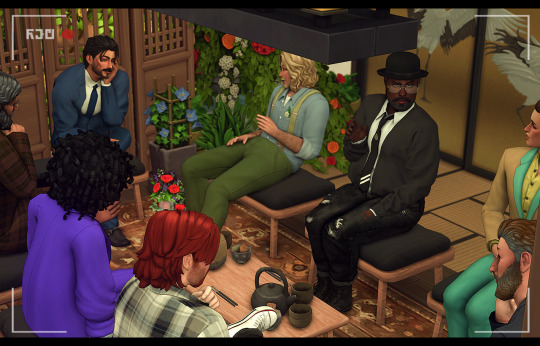
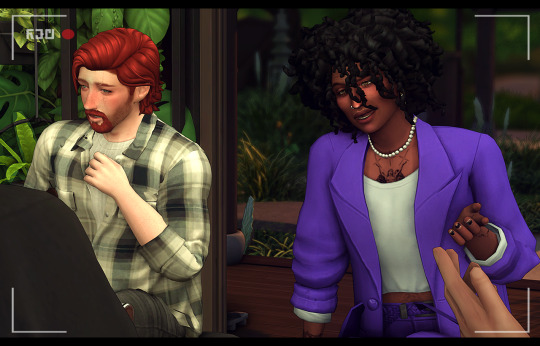



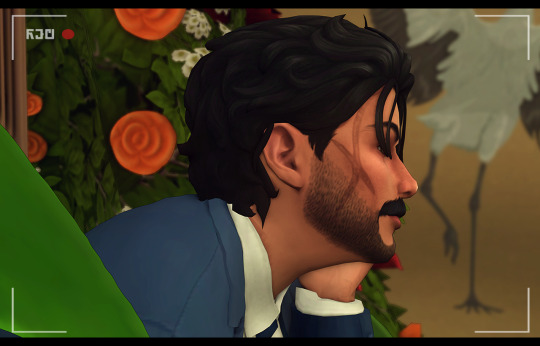
Kiss Me in Komorebi+ 🌸
[Episode One] First Impressions.
Our Bachelor enjoys a starting course of traditional Komorebian teas and snacks with the lucky sims of House One!
below the cut we have some more details abt the gameplay part of this wonderful beginning to our "first impressions" group dates! canonically, this happened before the house two introductions: dan does not have the social energy to meet 22 new sims back-to-back! but curiously... it seems like our bachelor already has an idea of who he'd like to give the first of our three "impressions" roses to. i wonder who it could be? 👀
Part 1/3 | next.
We last left off with Ivor Korrapati's introduction, read it here!
@retro-plasma @buglaur @lre333 @rebouks @yikessims @kawaiishitty @akitasimblr
oh man, okay. this house has a solid 35+ friendship rating both ways between each and every contestant! i don't think a single one of them dislike anybody - they had a great time drinking tea and getting buzzed off of the drinks dodo made for them, and i barely saw any negative socials pop up!
okay so maxwell is a literal angel and would not stop doling out fabrication tips to everyone in the room! he and josiah have become fast friends and spend a lot of time socializing with one another! (though they do tend to ignore dan to do it hehehe)
they all played musical chairs throughout the date but josiah ended up next to dan the most! he constantly prompted him with "deep conversations" and kinda hogged him to himself for a good hour! good tactics, josiah ;)
fabian surprised me by having the "fear of crowded places" moodlet pop up in the middle of the ceremony. dan autonomously "discussed his tense mood" with him and it prompted him to make uncomfortable jokes until he lost his fear :')
dodo would not stop going outside to do push-ups alone dkfhf
ezra was a light of life and definitely directed the conversation all night! he made joke after joke, and had the entire group laughing and blooming with positive ++ friendship!
daithi would not stop falling asleep in his chair mid-conversation, even when he was having a good time! (but he also napped in the chair right across from dan, and managed to stay there the whole night ;)) he kept talking to dan about fizzing techniques and eventually managed to get him on his own outside for abt thirty minutes of solo conversation!
i love this little group of sims so much, thank you all for sending your babies to me!! i haven't forgotten about house three: i'm just... being a menace and editing the timeline of the story after i thought of a better method of pacing~
#ts4#ts4 edit#ts4 gameplay#ts4 screenshots#ts4 challenge#ts4 bachelor challenge#;kmik#sim: daniel#oo tags here we go#josiah bolton by retro-plasma#daithi murray by buglaur#darol bennet by lre333#fabian hawkins by rebouks#ezra ruiz by kawaiishitty#maxwell santiago by yikessims#orlando harper by akitasimblr#omg i love them all so so so much!!#it was seriously such a delight to watch them all hang out#yknow... after i WRANGLED THEM INTO SITTING DOWN#oh my god i don't know how people do#big households#trying to corral them together to interact with one another#instead of reading books??? impossible#i have a shot of them all huddled around a bookshelf lolol#but yes omg!!! dan surprised me#by having a hot memory pop-up IN THE MIDDLE#OF LOOKING AT THE SIM HE WAS THINKING ABOUT#so i took it as him thinking '.... huh ok'#'this sim has actually earned the first impression rose i think'
130 notes
·
View notes
Note
ohh wht are ur hcs on the tenmikoangies .. (either th pairing Itself or individuals i Do Not Mind :3)
Tenko
- she’s very very feminine and loves girly things and people forget that!!! She loves ruffles and painting her nails and doing her hair and she’s a very big feminist. Girl
- I’m a much bigger fan of the original Japanese “horrible boys” catchphrase instead of the terfy “degenerate male” we get in the translation. Speaking of which people joke about Tenko being a terf which I absolutely hate. She would not be a terf. She would welcome anyone who wanted to become a girl!!! Being a trans woman is amazing and awesome!! I think I’m a modern/hpa/nondespair au she would follow a lot of transfem creators like Dylan Mulvaney and Kim Petras, and she would LOVE chihiro. If Angie and Himiko didn’t stop her she would be out protesting for LGBT rights in front of the Japanese parliament every day.
- Although I do think she has some internal biases about transmascs because “why would you not want to be a girl and be a horrible boy?” But she’s working on it and trying to understand. She’s unlearning a lot of harmful biases her old master instilled in her- she doesn’t have a hateful bone in her body and loves her friends no matter what!
- I think she loves having long hair, but it definitely gets in the way doing martial arts, so she does a lot of elaborate and pretty braids and hairstyles with cute accessories like bandannas and scrunchies! She likes doing Himiko and Angie’s hair when she can too- she especially loves Angie’s curls.
Himiko
- Himiko loves close up magic we all know this, but I think she would also really love stuff like tarot, crystals and palm reading. She’s autistic and magic of all kinds is her special interest!
- she loves big cozy cardigans (cloaks) and fabrics with celestial patterns… I think she would be a fan of the olden town lmao
- in the nondespair au she has a black cat and a tabby cat named Midnight and Tiger
- she loves collecting shiny little trinkets, her room is cluttered but not in a messy way… it’s like howl’s bedroom
Angie
- fuck danganronpa canon I’m the boss now. Angie has curly hair I think. She’s so much more than the “crazy island girl” stereotype… augh
- she loves to go thrifting and go shopping at craft stores! You have to be careful with her because she can and will spend all of her money in one trip.
- she likes to cook! She makes traditional Polynesian food for her gfs!! Food is just another form of art after all!
- she doesn’t have a lot of issues with nudity because her culture she was raised in is just different, and while Japan has some non Eurocentric standards as well with communal bathing in hot springs and such, she can be a bit out there. Like she tends to walk around without shirts on at the house and if someone comes over she doesn’t think to cover up, she doesn’t wear bras, if she’s hot the clothes are coming off, etc. nudity isn’t sexual to her and that is okay!
- I need to do more research on different Polynesian cultures and decide which specific indigenous group she is, but I think it would be cool if she had traditional tattoos? It would mean she wouldn’t be able to use most public baths in Japan, but her culture is more important to her.
127 notes
·
View notes
Text
the miraculous mr. sunday -
(the magician)
(rarae aves’s slasher oc)

“You know, when I got my name, everyone in town was glad when Sunday rolled in. Nowadays I’m wondering if I need to rebrand. You, though - you can call me Seth. All my friends do.”
age: finally stopped aging somewhere in his mid-40s (5/22/1901)(taurus-gemini cusp)
birthplace: A town that doesn’t exist anymore in Western Kansas, USA.
height: 6’0”
current location: ominously close to the parish line near Greymoon, Louisiana.
favorite book: says it’s the great gatsby by f. scott fitzgerald (it’s really the wonderful wizard of oz by l. frank baum)
hobbies: travel (anywhere the wind blows, really), oddities and miracles, old-fashioned circus/sideshows, magic, and their history (especially in the US tradition), parties (mostly attending, never hosts much himself for such a gregarious fellow), and any and all forms of theater and performance. being with as many people as possible, far from the empty fields and endless wind.
occupation: former stage magician, now fixer for They Who Provide. Aspiring Necromancer.
(what he’d pick as his own walk-on music: I put a spell on you - screamin’ jay hawkins
what it actually would be: when the circus came to town — aurelio voltaire
fc: david dastmalchian, underrated horror darling of my heart.)
“You wouldn’t believe the kind of opportunities people just… throw away.” Seth Sunday flicks a vintage lighter open and closed as he speaks, almost without realizing it. He hasn’t needed it for decades now - no point in smoking when you don’t always need to breathe. it’s mostly there for him to fidget with, truthfully. “It’s not every day Destiny prostrates itself at your door, you know. You’d have to be awful conceited to act like it’s just going to hang around while you get your shoes on.” He laughs, and it’s a cold, hard little sound like something stunted from a lack of sun despite the warmth of his smile. “Me, I came up the old fashioned way.” The lighter flicks closed. “I saw my moment, and I didn’t wait for ‘my turn.’ I found my own way in. I gave everything I ever knew for just one chance. And now look at me.” He pulls another hand from the pocket of his long, oddly patterned black coat, but there’s something… unfamiliar about it. The fingertips are dark, as though they’ve lost blood and then been dipped in ash. The nails look like they’ll snag on any ephemeral trace of you they can reach. “You know the secret to getting everything you ever wanted?” he says, gazing almost admiringly at his warped digits.
The longer you look, the more you’d swear the air over his fingertips starts to ripple. As if something is stroking the very fabric of the space around you, toying with the individual threads.
When his eyes find yours, you feel like you’ve been shoved down a flight of stairs in the face of all that bottomless blackness. His smile isn’t so warm now. “I do.”
a history, of sorts:
Seth says he doesn’t remember his birth name. The one written in a mildewed family Bible in the middle of godforsaken nowhere, Kansas, on an overcast spring day in 1901. He doesn’t need to remember it. That child - later, that man - is dead. Has been for more than a century now.
He’d seen to that himself.
Seth’s parents were immigrants, would-be homesteaders in a countryside drenched in blood they were willing to overlook for the cheap promises of a government looking for labor. Then they were farmers. Farmers with shit luck in multiple regards: first in their curse of an eldest child, a sickly daydreamer with no stomach for the grisly aspects of tending livestock and no fortitude for planting crops, who spent good money on books and useless picture show tickets when it could have gone to food. Then in the fact that his mother got pregnant, again, far too late to save his parents’ marriage or for their struggling household to support more mouths.
But for a few years, the scrappy little family seemed to catch a break. For one blissful bubble after Isaac and Ezekiel were born healthy and hale, and there was a wheat boom in the wake of the first World War (the ‘Great War’, the war to end all wars, it had been called. So much for that.), it seemed like everything might just turn around. Father was strong, Mother was healthy, and Seth was set to inherit a thriving farm when it was his time.
Seth hated every minute of it.
He wanted more. He was meant for more. He wanted to be one of the people from his childhood in the center of the three rings on his one and only visit to a circus, or someone in the glow of stage lights, on his brief ventures into the city for errands, or one of the ghostly faces on the giant shimmering screen in the lone little theater three towns over. The farm was the handcuffs he couldn’t manage to unlock, as easy as the traveling magicians made it look. He didn’t want younger brothers, or aging parents that clearly preferred them and not him, or the responsibilities of the supposedly cherished oldest son. He didn’t want to be born and die on the same plot of land, buried somewhere the cows could graze over for the rest of eternity, his name only ever meaning wasted potential. He’d tried to enlist for the Great War, tried to get sent abroad like other boys he knew. He was a little young, but he was tall for his age even then, and he almost - almost - got away to see the world.
But his father, a cheap bastard if he’d ever known one, had somehow scraped together enough money and their best cow to bribe the recruiters who came to town looking to look the other way. He wouldn’t dignify pretending it was done out of love, either. His father was a pragmatic man. He’d known that it was only ever about keeping enough labor for the farm, especially with his mother newly pregnant at the time.
His life as he knew it was only ever in service to those around him. Their choices defined his. It was enough to make any man see red, after so many years.
Then came what would be known to later generations as the Dust Bowl, and Seth’s world turned black.
The crops withered up, and so did the cows. Dirt swept through the skies in curtains so thick it blocked out the sun. There was no surface in the little ramshackle house that wasn’t covered in it by nightfall, no matter how much one swept or wiped or screamed. For years, it felt like his every breath was studded with grit. He had nightmares of being buried alive in the miserable barren plot that used to be the pasture.
Just when he thought he’d choke to death on it, his father beat him to the grave, leaving him and his fragile mother alone with his two boisterous brothers.
He was the man of the house, now, and it made him want to claw off his own skin.
So much so, he thought it was worth trading someone else’s to escape.
It’s no surprise that certain folklore has a habit of dispersing itself, even through a country as vast as this one was already. Tales whispered in half fear, half hope by the desperate circulate like much-needed storms, especially when those storms refuse to materialize.
It was Seth’s idea to go to the crossroads, but he let his mother think it was hers — a half-remembered story from the old country, rather than something strange he’d found in a book long forgotten under his bed.
The little family trekked there together, walking the miles in shoes close to worn through, and only just reaching the nearest junction when his father’s cracked pocket watch read midnight.
Seth had been chosen to ask for the family’s salvation, for the ability to carry them all on for another year — he had the best English of the family, and what else would a demon speak in a land like this? But when something emerged from the darkness like it was a curtain, asking in a voice like smoke what he wanted…
Seth spoke up for himself, for the first time in his life.
He only felt a little bad when he saw what the demon did to his mother. But he couldn’t deny his own glee when he saw what happened to her precious twins.
Before a quarter of an hour had passed, Seth could make fire appear at the tips of his fingers, could make coins appear from thin air. The things he could do would have caused his idol, Harry Houdini, to break into a nervous sweat. Everything he’d ever dreamed of as a lonely boy in the fields, he could do at his own merest whim.
Seth ditched his human name, and at the demon’s suggestion, adopted the surname of Sunday. “The Miraculous” had been his own touch. It was finally his turn to be the miracle he never was to his folks.
And for decades, he was. He was beloved in the small towns he stopped in, his own traveling show, with a rotation of beautiful assistants at his beck and call over the years. Nothing was ever too good for him, he could dazzle his way into anywhere he wanted.
As long as he kept things square with They Who Provide, he was living the good life.
…But times have a habit of changing. As the world grew, magic - both real and sleight of hand - shank in its influence. For all his caustic nature, Seth Sunday was ill-equipped for a world that finally matched his inward cynicism.
And what did They Who Provide need with some little nobody from the middle of nowhere, when they had entire established families, generations of magic, at their beck and call?
After decades of earning his keep by tying up his benefactors’ loose ends, Seth finally heard something very interesting: A whisper of a family down south that was refusing to hold up their end of their contract.
A family with power over Death itself.
…Well. If there was an open spot to fill, and no one there to fill it, Seth saw no reason he couldn’t throw his own metaphorical hat in the ring.
After all, he has plenty of experience keeping demons satisfied. What’s three more names to add to his list of sacrifices?
There was always something to be said for reinventing oneself when your act was getting stale. He could see himself growing into “The Miraculous Master Lazarus” just fine.
#the miraculous mr. sunday#seth sunday#slasher oc#necromancer oc#magician oc#david dastmalchian fc#morvant mortuary#monsterkisser fics#(not affliliated with the appreciation tag for actor seth numrich)#(I've never seen him in anything but he seems nice. good for them.)#ofc I introduce him on world goth day are you kidding me#(eta: idk wtf is going on with the spacing excuse me while I fix that)
37 notes
·
View notes
Photo
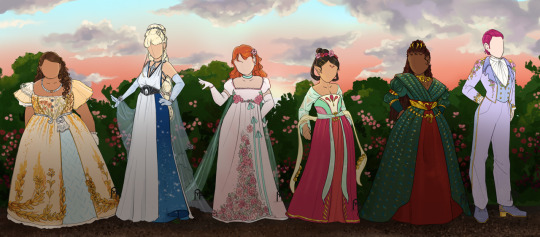
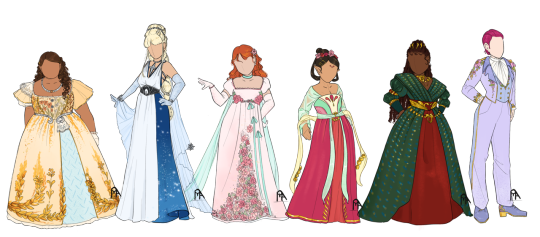
✨S3 Ballgowns!✨
Some notes and thoughts
Flora, Bloom and Tecna are wearing what is considered fashion on Eraklyon in the butterfly!verse (loosely 1820-1850s European fashion)
Flora has a crinoline skirt with a relatively short corseted top that is embroidered with flora representing the four seasons. She is rarely wearing yellow, though I think it would suit her immensely and when else would she indulge her princes-ly fantasies than when she is invited to a proper royal garden party? Asymmetry is very big in Eraklyonite fashion, as seen on her sleeves and split skirt (not that that detail is very true to historical fashion)
Bloom continues with a penchant for vintage and vintage inspired as she has managed to rescue a beautiful Eraklyonite gown from a magics charity shop, that just so happens to be a few decades old. As a reference, the empire waistline is very 1800-1810 and would be considered something a bit outdated, and generally seen worn by an older demographic). It’s a nice dress regardless with a lot of pearl and puffy textured rose embroidery (not by thread but little chunks of fabric if that makes sense). Her choker fans out into this 60s inspired gauzy train that floats behind her in the wind.
Tecna is wearing a cropped take on a frock coat with reference to men’s corsetry (though colour choice and embellishments are more Rococo than Romantic). This would mark the first time in the butterfly!verse that Tecna has fully liberated themselves from gender expectations and envy about the confidence the rest of the winx carry their femininity and is embracing more masculine styles of dress (for formal occasions at least). I still wanted the silhouette to be tailored and the garment shiny and embellished as fuck.
Musa is in a Melodean gown that is inspired by Tang dynasty (again more vintage than the current fashion that I tend to put Galatea in, which is Ming dynasty era). The scarf, huadian (forehead paint) and hairstyle are direct period typical references. I imagine this is a summery dress constructed of 4-5 layers of thin silk, giving it a nice fullness and movement while walking and dancing. Musa likes to experiment with intergalactic fashion, on formal occasions she frequently goes back to traditional Melodean styles even in the show, so I didn’t think she’d want to buy a new dress like the rest of the girls.
The two princesses are representing their royal families and have appropriate gowns to match.
Stella is wearing a Selenite design consisting of a plisse-d thin tunic over a dark blue dress beset with jewels to mimic stars on the night sky. The train originates from the shoulder clasps of the tunic and can be attached to her bracelets with the metal brooches fixed to the corner of each piece. (It is one piece per shoulder, not a continuous one). Most of the time Stella is the poster face for the capital, and with that the Rai culture that she more closely relates to, but she does switch it up from time to time - or just does her own thing. On Eraklyon political tension dictates she endears herself with her Selenite heritage to the upper classes, so that’s what she does.
Layla is wearing a “visiting dress” a style of fashion Androsians mimicked based on the fashion worn by the off world people they made first contact with (that just so happened to be people from Manubra 47 3000 years ago). That being said the gown draws from Elisabethan fashion but is meant to be made from fabrics inspired by African handprinted fabrics. Red garnet being Layla’s assigned birth stone, most things she wears are embellished with it. The little wave hairpieces are Layla’s royal heir “crown” that she wears with almost every formal dress in one form or another.
#winx club#winx club redesign#season 3#season 3 gowns#winx ballgowns#winx stella#winx flora#winx bloom#winx musa#winx tecna#winx layla#winx aisha#locally sourced art
399 notes
·
View notes
Text

Just as SimDonia has changed greatly throughout the years, so has the fashion and trends. The clothes of SimDonia's past tell a story about the country's rich and complicated history. Join us on a little journey exploring SimDonia Stlye and the impact politics played on the popular fashions of that age.
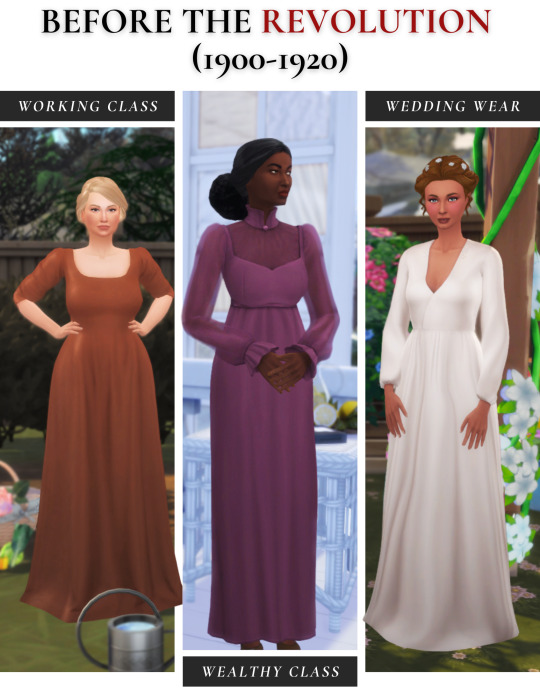
During this time in history, SimDonia was not yet formed. The region was referred to as Pendula View and was ruled by The Goths under a strict dictatorship. Under The Goth empire, poverty ran rapid, wealth disparity was high, and morale was low. Every month, supplies were distributed to all the citizens of Pendula View by the government. These parcels included things like milk, eggs, fabric, etc. The more acres your family owned, the more you would recieve.
Working Class - For working class families who owned little land, they never recieved much from their monthly parcels or would get the scraps. These folks would use the fabric they recieved or whatever they could obtain to make clothing which was often poorly stitched and plain-looking. Modesty was expected for women and pants were not yet introduced. So women tended to their farms, homes, and families in long-sleeved, floor-length dresses.
Wealthy Class - While wealthier women were able to acquire better fabrics, and have their clothes made for them, they still had to be modest and wear their hair up. Bella Goth was said to be jealous and vain and always wanted to be the best looking woman in the land.
Wedding Wear - Women were not permitted to wear makeup (although many wealthy women were able to bypass this rule), except on their wedding day. Modest clothing was still in place. Flowers were often worn in the hair to signify a blossoming and beautiful marriage.

The people of Pendula View eventually could no longer take the treatment they were facing at the hands of The Goths. This started the SimDonia Revolutionary War where the people fought for their country. This brought hard times for everyone, but we can see trends in fashion reflect in what was going on at the time.
Working Class - The most active, loudest, and bravest voices during the revolution came from the working class as they fought to liberate themselves. In terms of fashion, we started to see short sleeved dresses versus the traditional and mandated long sleeve. This was an act of rebellion including wearing the hair down instead of up.
Wealthy Class - Wealthy folks were conflicted. They did not want their lives derailed or their fortunes in jeopardy due to the revolution, but they also relied on the working class for labor often paying little to nothing or even bartering supplies for services like making clothes, tending to children, working their lands, etc. This conflict brought on the off-the-shoulder dress trend where women would show solidarity with revolutionaries by bearing their shoulders, but would quickly pull their sleeves up when among those against the war.
Wedding Wear - The short sleeve trend followed into wedding attire, but so did another. Women feared their dress would warrant punishment from the government, so they began to wear veils to conceal themselves as to be harder to detect.

The Goths have been defeated! Huzzah! This was a time of celebration in SimDonia as the new government system was formed for the people by the people! SimDonia pride was high, wealth was better distributed, and morale was skyrocketing.
Working Class - Gone were the monthly parcels and low paying jobs! Poverty was at an all-time-low! So, we saw more working class folks in higher quality, better stitched, more colorful fabrics (SimDonia red was ultra popular at the time). Short sleeve dresses were here to stay!
Wealthy Class - The war efforts did little to benefit the rich who relied on cheap labor. With more working class folks coming up in the world, it meant wealthy women had to differentiate themselves. As working class grew more lavish, so did wealthy folks with big ballgowns and even better fabrics.
Wedding Wear - Dress became more lavish for weddings as well. Veils are still popular but are now worn behind instead of covering the face. Jacobanism was able to be practiced openly. Jewelry was also now allowed to be worn in grew in popularity with all people.
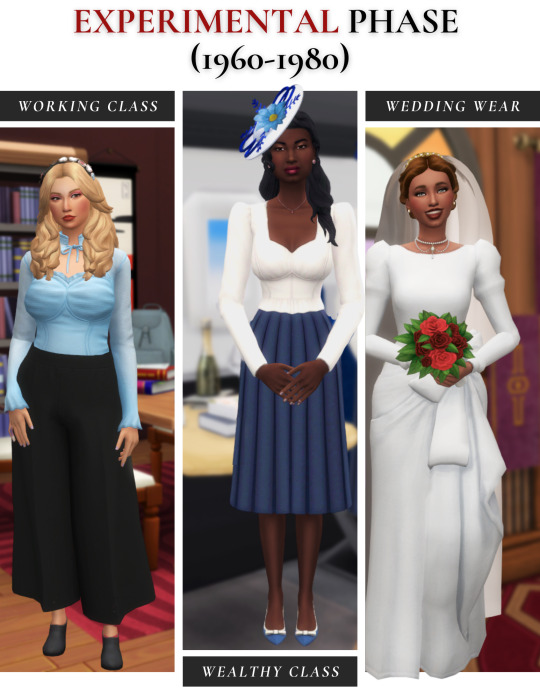
This period of time is known as the experimental phases of SimDonia fashion. The society was still new and establishing itself. The increase in wealth meant more education. Seeing as SimDonia had not yet built a university, students went abroad which opened SimDonians up to new cultures and styles not done before. Many which were brought back to SimDonia and incorporated into SimDonia style.
Working Class - Many students studied in Simerica, Komorebi, Selvadorada, Sulani and more. More and more people were also immigrating to SimDonia which helped create new styles. Pants were finally introduced and as SimDonians transitioned from skirts, wide-leg pants became popular as a result. Color, designs, and materials were also experimented with along with less modest clothing.
Wealthy Class - Seen as traditionalists, wealthier people often stuck to modest wear. Most didn't hop on the pants train either. But, more interesting designs and trends emerged from the experimental stage including fascinators which are worn heavily amongst the wealthy today.
Wedding Wear - Wedding design also saw some experimenting. Viels got longers, dresses saw more embellishments, and accessorizing was a must. Flowers went from being popular in hair to being popular in bouquets.

Today, SimDonia Style is trendy yet true to its origins. People are encouraged to dress in a manner that suits them and creativy and expression through dress is common. Not only has SimDonia caught up with the rest of the world, but has become a trendsetter on a national stage prompting a near fashion capital status.
Working Class - Without rules or regulations, we see more and more creative trends blossom. High fashion is more accessible than ever and expression is at an all-time high. Many attribute not only SimDonia's liberation, but experimenting, appreciating other cultures, and a sense of pride and freedom to today's fashion.
Wealthy Class - While wealthy class fashion could still be considered restricted, it's 100% socially and not required by government. Modesty still plays a role, but there is less concern to differentiate oneself with working class.
Wedding Wear - Today's popular wedding trends still remind us of SimDonia's past and history. While looks are more simple, brides have the freedom to get creative and personal on their big day.
#simdonia#worldbuilding#simdonia style#yayyyyy#I'm very proud or this#i'm sorry that it's so long#but I was too excited to be short lol#all the detail lol#and I feel like there is more I could say!#there is a link to my history post btw#at the top#and of course if you have questions#I got answers#thanks for reading!
75 notes
·
View notes
Text

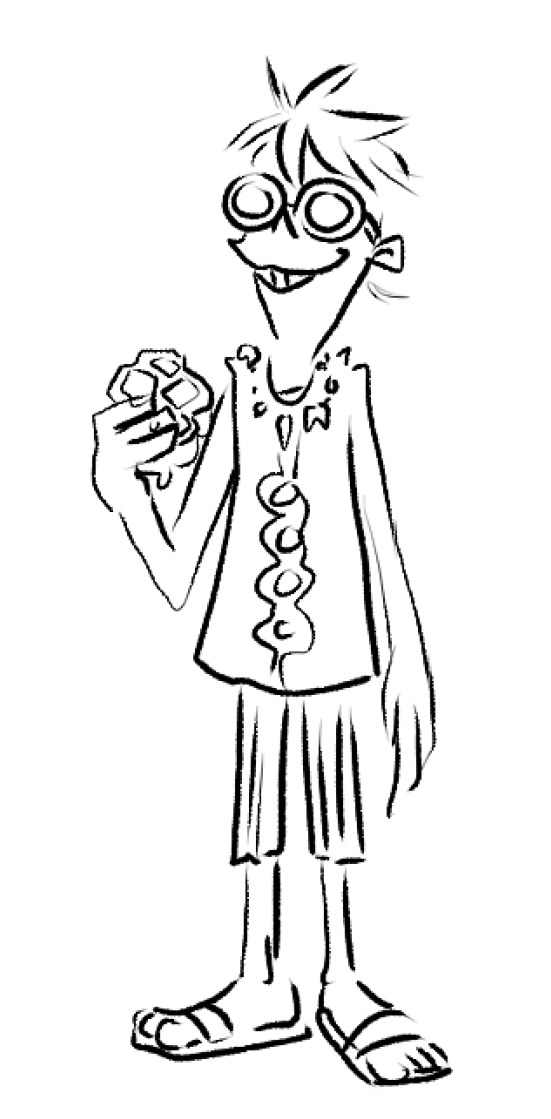
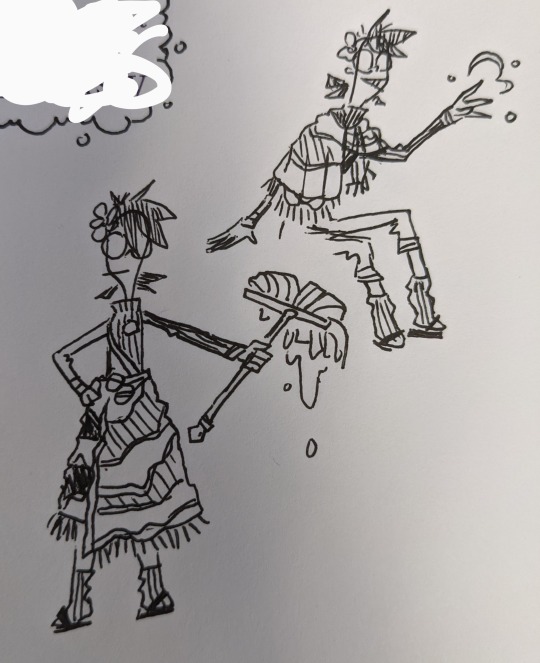

(PSYCHONAUTS 2 SPOILERS IN FIRST IMAGE TEXT ESPECIALLY!!)
oh boy we've hit the point in my Psychonauts art backlog where we get into my OVERLY ELABORATE AUs!! This first one is what I call the "Cally O'Pia AU", which is basically "everything is the same except Cassie stole rescued one very specific weird little boy from a psychic lobotomy, and he grew up raised by her instead. There's a lot more content for this that I'd still like to finish someday, so I'll leave it there for now! There's another AU I've worked on more that you'll be seeing a LOT more of soon, though...
(Alt text/image IDs under the cut!)
[Image 1 ID (PSYCHONAUTS 2 SPOILERS IN DESCRIPTION): A sketchy, colored design for "(Caligosto) Cally O'Pia", an alternate version of Loboto who was raised by Cassie. He is posing with one hand on his hip and the other gesturing outwards; he has both original arms rather than a prosthetic. He has a full head of hair in a sloppy bob with long bangs and a yellow flower tucked behind his ear, wears glasses with green and red lenses instead of the inlaid lenses, and wears several multicolored bracelets and necklaces resembling Cassie's. He is wearing a janitorial staff Psychonauts uniform with the sleeves rolled up, half dark teal-green like an agent uniform and half-lilac purple. Over the uniform, he wears a long handmade-looking light-yellow skirt with pink tassels along the bottom edge, patched with several long patterned scraps of fabric as well as several smaller square patches. He is also wearing blue ribbed socks with light-brown sandals, and two fanny packs on his waist, one purple, one dark blue. There are bullet points about his personality and backstory next to the design, reading:
- Picked up by Cassie during a Psychic 7 run on hospitals performing lobotomies (she got a little overzealous seeing a kid on deck and just. took him and ran)
- Never met Lucrecia; she'd already left for Grulovia by the time he was adopted
- Kept training with the Psychonauts, but became increasingly disillusioned seeing the Psychic 6 fall apart (especially when Cassie retreated to the Gulch)
- Extremely powerful psychic, but blows off responsibility to the point he's all but useless as an agent; mostly tends to the aquarium and acts as a handyman
- De facto custodian of the Gulch, since he's the only agent who can reliably make it in and out (he's going to check up on his mom)
- Openly bisexual; in an on again-off again relationship with Oleander (both would rather it stay on but neither are emotionally mature enough to admit it)
- Suspicious about the circumstances behind Maligula's defeat & the "official" Psychonauts founding; took on the moonlighting half from disillusionment, half to secretly investigate without influence (Oleander knew & would occasionally help)
- Took the Deluginary job to get info on Maligula, didn't know about the plan with Truman until too late (no hard feelings against the guy himself, y'know?); realized he was in over his head, leaked coordinates to Raz & co. but got threatened into finishing the job regardless
- Considered leaving the Psychonauts to be a dentist or marine biologist when he was younger; couldn't bear to abandon Cassie
- One of the only agents to still regularly visit Compton in Psychoisolation
- Picked up some writing skills from Cassie (he likes freeform poetry)
- The socks with sandals are absolutely, specifically to piss off Hollis. Come at him.]
[Image 2 ID: A younger Cally O'Pia. He has messy hair, glasses, a big smile, and is eating a chunk of honeycomb. He is wearing a long tank top resembling Cassie's dress, over pleated pants that reach mid-shin, and sandals.]
[Image 3 ID: Traditional pen sketches of Cally O'Pia. In the left, he is standing with a neutral expression, one hand on his hip and the other holding up a dripping mop; in the other, he is sitting, grinning and using his psychic powers. In the second image he has removed his wrap-skirt to wear it as a shawl around his shoulders instead, revealing the Psychonauts uniform jumpsuit reaches about mid-shin on him.]
[Image 4 ID: A sketchy three-panel comic of Cally and Oleander. In the first, Oleander, wearing boxers and an unbuttoned shirt over a tank top, walks down a hall shouting "Cal??" Cally, standing around the corner wearing sweatpants and a baggy shirt, using telekinesis to bring plates over to him to dry, replies, "Kitchen". Oleander continues, "I can't find my All Paul shirt". The second panel shows Cally shifting his weight onto one leg as he dries the plate with a rag, nonchalantly saying, "Mm. Haven't seen it." Oleander, now looking directly at Cally around the corner, says, "Cal". "Yeah", Cally replies. "You are wearing the shirt", says Oleander. The final panel shows Cally, grinning knowingly and continuing to dry the dish, replying sing-song, "Dunno what you're taaalking abooouuuttt". Oleander, bracing his feet against Cally's lower back and tugging at the hem of the shirt with both hands, screams, "CAL SO HELP ME". Cally simply responds, "I look good though right".]
#anonymous puzzler art#psychonauts 2#caligosto loboto#psychonauts 2 spoilers#rhombus of ruin spoilers#morceau oleander#cassie o'pia#tw for mention of medical abuse (specifically lobotomies)#one fun bit of trivia that I wrote after that little character bio that i *will* share#I decided Cally also does a ton of writing for true psychic tales under a pseudonym#he mostly sees it as propaganda-y schlock but he's *very* charmed that Raz is such a big fan
71 notes
·
View notes
Note
the intimacy of prince!levi tending to/patching up the wounds of knight!reader after reader gets back from an expedition (ft. levi's usual stern but affectionate chastising and lecturing)
Oh the intimacy of having someone take care of you... of putting you back together... far too much... I was gonna offer you a traditional, “Don’t be so reckless next time,”—translation: don’t leave me next time—scene, but instead I offer you this excerpt from that prince fic I’ll never complete teehee.
cw: mentioned/descriptions of blood and injury

It takes two weeks for you to be able to leave your bed, outside of essential trips to the bathroom, after regaining consciousness. It feels slow and agonizing, even with your catalyzed healing abilities, but Moblit applauds you and reassures you that your recovery is incredible, and escalating far more quickly than anyone could have hoped for.
The shallower cuts have healed by now, leaving only scars and stained skin in their wake. The deeper gashes along your sides, arms, and ankle remain wrapped and careful monitored by Moblit and the other nurses; as do your stab wounds and the burns on your right arm—it’s wrapped from shoulder to wrist, the bandages extending around your pinky and fourth fingers that were heavily sprained.
Your bedside attire consists of open-back cotton gowns and loose, but elegant robes that allow your nurses easy access to your wounds. But, to venture downstairs for dinner, you would need to find something more sightly to wear. Your standard uniform was out of the question, and to your knowledge, out of commission; and even if it were to be pieced together and polished, something as routine as strapping your armor to your suit would bear a significant burden in your current state. Even more casual attire expected of the knights would be difficult to wear—pants and thick shirts would only serve as invitation to chaffing, and further irritation to your wounds.
You don’t own many gowns outside of those provided for surgical ease or for formal events. A skirt might be the solution to the bottom half of the equation, but finding a matching blouse that you could fix to button up with your six working fingers posed another challenge. With a sigh, you carefully close the drawer shut, and take a seat in front of your vanity. You understood the risks of your actions, and that recovering from your injuries would be gradual and frustrating, but you hadn’t anticipated your difficulties would start with your clothes.
Luckily, you were blessed with people who had anticipated this. Isabel comes by with Farlan and Eren in tow, maneuvering handfuls of dresses into your closet. The princess informs you that she and her mother have sent your measurements to the tailor to have more made for you—along with a variety of loose shirts, skirts, pants, and undergarments.
She refuses to accept your protests for any further special treatment, busy with ordering the boys about to make room in your boudoir for more slippers and robes—only allowing them to rest when she deems their work satisfactory. “We’ll leave you to change! Eren’s got some boring papers to read, and I’m making Farlan go riding with me before the table gets set, but Armin should be heading over here soon to help you get downstairs,” Isabel exclaims, clapping her hands together, “I’m so happy you feel well enough to come to dinner. I missed having you at the table.”
You thank her and the boys again before they exit, waiting until the door is shut behind them to take ginger steps towards your wardrobe. You’re aware that your armor is costly, but there’s an undeniable luxury about the garments gifted to you that outweighs the bronze and gold you’re accustomed to wearing. Your uniform is hard, resistant, tough; these gowns are soft, light, and smooth to the touch. They are not gifted without thought—non-irritable fabrics with little or no buttons, at most, a single zipper that even your limited grasp can handle.
Carefully, you select a dark blue piece from the crowd: a silk slip that slides over your skin and falls at your heel, with delicate lace trimming around the neckline and wrists. The fabric is light on your shoulders, but weighs heavy on your mind; this is one of the Queen’s gowns, and although Kuchel has always been more than kind and welcoming to you, you can’t help but to be reminded of her status when adorning one of her dresses. You figure the least you could do to honor the material is to wear it the way it was intended to be styled, so you reach your dresser to find an appropriate corset.
You settle for a white one with a softer skeleton that you figure won’t sit too uncomfortably on your wounded torso. Fitting it around your waist proves to be the easiest part; attempting to lace it and position it properly is where your limited mobility and strained muscles are highlighted.
You must spend at least ten minutes trying to fix the damn fabric on your body—hissing when you move too sharply, cursing when you lose grip of the laces, huffing when your arms grow tired. So, when you hear a gentle knock after your fifth attempt at stitching your corset, you’re relived—believing it to be Armin, you call for him to enter, “I’m glad you came. I think the stairs should be fine, but I need your help with—”
“What the hell do you think you’re doing.”
The voice is dark, heavy, and cuts through your pleas with that question, phrased like a declaration. You needn’t turn to confirm your suspicions; and Levi’s eyes are steely and scrutinizing in the reflection of your mirror.
You choose to blame your hesitance on your injured state, unable to react normally as you continue to watch him in the mirror as he takes strides towards you. Levi pushes your hand away from the laces of the corset, holding the offending fabric between rough fingers and questions you through the mirror, despite his proximity, “You were stabbed in the side twice and you think to put on a corset?”
He holds eye contact, even as he unlaces your hard work between every word. You part your lips to protest, never minding Levi squinting at you. “The dress is typically worn with one, though I suppose you’re right—a waistcoat would have proven to be easier.”
“I was not insinuating that you need something in place of this,” Levi says, setting the corset onto the bench once it’s off your body. You know that; he presses anyway, carefully reaching to your side to adjust twisted fabric before holding your gaze in the mirror once more, “It’s fine on its own.”
You don't dare to protest again; any excuses becoming meek in your mouth as you hold Levi’s gaze—unwavering and headfast with room for gentle affection. It's a look his mastered well, you think, considering how often he throws it your way.
A protest will fall on deaf ears; an alibi cut with a silver tongue. So, instead, you offer the truth: “I wish not to draw attention to myself.”
Levi squints again, barely, but you catch it—not scrutinizing this time; wary, almost, of what you’re not sure. You don’t question him, even as he breaks eye contact to look at your right wrist, carefully raising it between his fingers, “Then don’t get blood on your sleeve.”
Your eyebrows pinch together before you look down and see red seeping through the bandages around your wrist and palm. You curse under your breath, realizing you must have reopened a tender gash with repetitive movements. You part your lips again to speak, but Levi does so first: “It’s old, anyway,” he says, “Moblit didn’t change it yesterday. Sit, I’ll fetch more.”
“You don’t need to, I can—”
“You can wrap your own bandage with your non-dominant hand that has two splinted fingers,” Another question delivered as a statement, followed by a command this time, “Sit. I’ll get more.”
You nod shallowly, and carefully resume your seated position, noting the way Levi watches you again through the mirror; only when your sat completely does he turn to bedroom to retrieve more bandages—almost out of sight before he turns around, walks back, and grabs the corset to take with him.
You laugh—genuinely, for the first time in a long time when the prince turns his back to exit your boudoir again. “That wasn’t necessary,” you taunt, laughter still seeping through your syllables.
“You’re stubborn,” you hear Levi hum, before he turns his head to look back to you in the mirror. “I know you.”
His words prompt further laughter from you, and he turns his head before you can see the gentle smile that graces his face.
“You think so?” you question, watching his back in the mirror as he pauses just under the door frame. You watch how gently his hair moves when he nods, not sparing you a glance this time when he speaks, “I know you very well.”
#anonymous#the more asks i get about my graveyard fica#*fics#the more im like wait i kinda liked this LMFAOOOOO#i cut out some stuff in the middle bc it related to Plot that doesnt make sense without context but hehehehe#levi my most beloved... oh when ur the knight who gets injured and your prince assumes the role your caretaker now..... enough#levi x reader#aot x reader#snk x reader
67 notes
·
View notes
Text
Three Clerks
Last week I tweaked my back. It hurt. A lot. As I recovered, I found that sketching with pen and pencil was less strenuous than writing on keyboard. So that's what I did.
Sketched characters from an adventure I am currently writing for Colin Le Sueur's We Deal In Lead. It began as a homage to Wisit Sasanatieng's tomyamgong western Fa Thalai Chon / Tears Of The Black Tiger.
+++

SHIN SUL SHAP, SHRINE CLERK
4 Grit 10 STR 10 DEX 10 HRT
Switch (d4)
Face hidden by a broad-brimmed bonnet and veil. Patrols the lines of pilgrims; like a schoolmarm she thwacks anybody chit-chatting. Piety should be silent!
A waif snatches a lead token from her pouch, and bolts. A chase ensues. He begs your help. If Sul Shap finds him, she will sell him to captive takers.
+
Sul Shap is a clerk at the Shrine To The Headless Sun: a bare plaza; a marble pavilion; a golden man, with an ever-burning flame where his head should be.
The Headless Sun is patron saint of the Admiralty, whose laws now govern both Ocean and Sea. He was its founder. The kings of old captured and beheaded him. He overthrew them anyway.
+++
References for Sul Shap were basically Buddhist nun robes (mainly for the volume of fabric), plus an European bonnet.
Initially I'd imagined a conventional broad-brim hat---ie: her veil would be a cylinder around her whole head. But as I sketched I thought the bonnet made a more interesting shape? Also its rear was an opportunity to create a crest / halo of sun-rays. Religious iconography!
Alms bowl, because giving is a virtue. But the Headless Sun values ego-death, not asceticism---so colourful beads and gold amulets and pouches full of lead tokens (money).
+++

RIS SHAY NAM, RECORDS CLERK
2 Grit 10 STR 10 DEX 10 HRT
Swung typewriter (d4)
In a wheelbarrow, pulled by a servitor, typewriter balanced on her belly, pockets filled with banana fritters. Greasy fingerprints on any document she works on.
Shay Nam thinks herself a moral soul. Will side with abolitionists and revolutionaries, with justice—until her own skin is at risk.
+
Shay Nam works at the Hibiscus Court. Princess Khur San, distancing herself from the old order, surrendered this palace to bureaucrats.
Clerks have filled its once-airy halls with shelves. By sympathetic sorcery, all contracts in the province manifest copies here. Rumour has it that this magic works both ways.
+++
This was my first sketch. In pain and bored I just started drawing.
No references, and it shows? Skirt and stockings and boots because these were the easiest for me to do. In my mind Shay Nam was an archetypal overweight NEET. Here she looks to be a sassy layabout. I like her better, now!
Also: a servitor is an empty body. Created when you ritually touch a shrine-stone to the Headless Sun---your soul is obliterated. What is left behind is mindless, hence the harness and reins.
+++
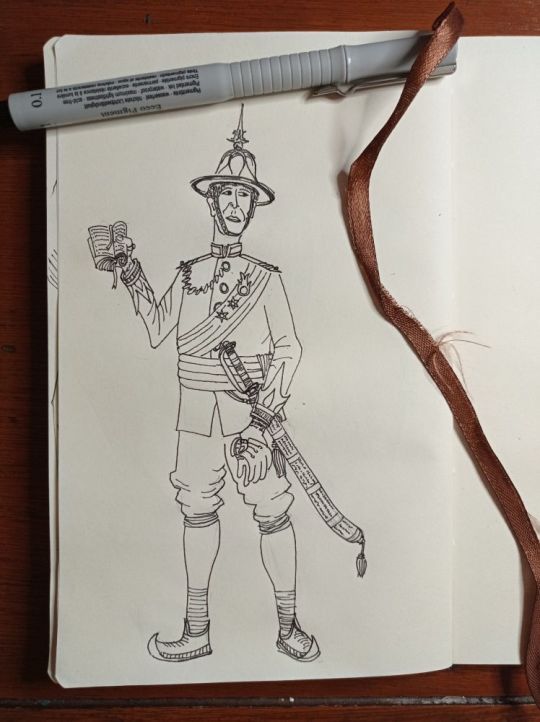
KHAN YUL MIN, COURT CLERK
4 Grit 1 DEF 10 STR 10 DEX 10 HRT
Sabre (d8)
A university grad and former marine. But his townhouse sits below Rose Hill, on Merchant’s Row, beneath the old families' notice.
Yul Min means to change this. He has his eye on the Widow Gon. He will hire ruffians to waylay her palanquin—then swoop in, to rescue her. Elaborate theatre.
+++
Yul Min, like all these characters, live on the Sea of Sorrows, whose waters are literally the souls of the dead.
Roses always bleach within sight of it; to retain their colour they must be shipped in glass, then kept in arboreta—never once sharing air with the Sea.
Those who can afford red-rose gardens tend them on the south end of the city, where streets begin to climb Mount Go, in compounds walled like fortresses.
+++
Drew Yul Min last night. Had tabs open for "Thai traditional clothing" & "military uniforms 18th century" & "krabi" & "Vajiralongkorn".
Given my inspiration, I think the referencing of Mainland Southeast Asian material culture is appropriate. Maybe a little to obvious, though? Ie: the visual forms haven't been composted well, into new and more imaginative shapes ...
Still: very pleased with the proportions and details.
I liked how the hamsa-esque icon of the Headless Sun developed over the course of these sketches. I would not have discovered it, otherwise; it's one of those details, too small for words.
Drawing is an intrinsic part of the writing process, I guess!
+++
#writing#art#illustration#sea of sorrows#ttrpgs#characters#clerks#process notes#we deal in lead#fantasies#adventures#settings
13 notes
·
View notes
Note
Hi quick question about sea glass gardens was the servant that megumi was talking about Mai or someone else.
ps is Yuta going to meet Mai? Keep up the awesome work by the way
It wasn’t Mai.
Mai isn’t a servant on the Zenin estate right now—she was supposed to be, but they made her become a sorcerer in training with the Kyoto school when Maki went to the Tokyo school. She’s not considered a servant anymore by the Zenin, and she isn’t tapped in for any servant duties.
I honestly didn’t really have a specific character in mind with the servants Megumi discussed—they’re all just Zenin who weren’t cut out to be an active sorcerer who were shuffled off to be a servant instead. The most detail we get about is about the one who took his measurements for the kimono, who let him sleep. She’s also not any specific character from canon, but she is a sort of tie back to a comment Maki made earlier in the fic. When she was telling everyone what the kimono was in chapter 5, she mentioned that the kimono was treated better than most people at the Zenin compound, and that it had its own climate controlled room and a full-time caretaker. The full-time caretaker was the one who took Megumi’s measurements.
The idea was just that the Zenin probably had people who specialized in the more technical chores instead of it just being shuffled off on rotation. Like, if you have an ancient text in the Zenin library because the Zenin have been compiling information on the Six Eyes for the past 1000+ years (which, according to Gojo’s monologue during his fight with Toji, they have been), you probably need someone who’s trained in handling materials that old. Or if you’ve got an entire storeroom of priceless cursed tools, you probably have at least one person dedicated to learning how to actually maintain them in a way that keeps them in good condition.
The kimono caretaker is just a Zenin who wasn’t strong enough at cursed energy to be considered for a warrior but had enough of a natural inclination towards fabrics that she ended up getting apprenticed to the last caretaker. In my head, the Zenin actually sent her to regular university to study the preservation and maintenance of ancient fabrics, and she’s actually pretty well educated by the standards of the outside world. Like, to a doctorate level. Which is why Maki said it’s a pretty good gig to get if you’re good enough with fabrics—the Zenin will fund your education, and you get away from the compound for a while. It’s also just a little bit of a status symbol to be specifically designated as the caretaker of the ten shadows kimono instead of just your random, run of the mill servant on the laundry rotation.
None of that background info is ever showing up in the story, so I don’t consider it a spoiler or “canon” within the universe of sea glass gardens. I believe in death of the author, so if it’s not actually in the work, I always tend to have my own like, background lore about it, but none of that is binding on the audience. It’s just fun ideas that live in my head that y’all can take or leave.
On that note, in the confines of my head, her experience with the outside world was part of why she let Megumi sleep.
The Zenin clan are so tangled up in their own narrative about him that they’re all predisposed to sort of justify what they do to him. He’s the Ten Shadows. He’s got the clan’s most treasured technique, of course he’s going to uphold all of their traditions around it. That was never a question. They’ve been waiting for this for centuries, and he’s the necessary participant who needs to get with the program and start being everything they want him to be. And they all live in an echo chamber. They grow up and live and die and intermarry all on the same compound, and their contorted narrative sort of breeds like bacteria and it’s very hard for other viewpoints to take root. So it’s very simple for them to justify things like “and now we kidnap the boy who wants do little to do with us that he went no contact because his adoptive dad is off fighting a war to defend the society we are a part of and finally can’t stop us” and “ehhh let’s just lock him in a room with things that will try to kill him for a while” and “now that he’s injured and too exhausted to resist, let’s force him into a bathhouse where a lot of strangers will touch him explicitly against his will” and “the teenage boy doesn’t want people to watch him get dressed but we’re doing it anyway” and “well he’s in critical condition now but we got what we wanted so good job team.” Like, all objectively fucked up shit, but they all live in such a batshit crazy echo chamber that they all view themselves totally justified and in the right for what they were doing to him.
But the caretaker had popped the bubble around the Zenin compound, so to speak, because she had to spend so much more time in the outside world for her education. And so she walked into the room still bought into the echo chamber, and then she got in it… and the Ten Shadows was just an exhausted fifteen year old kid who was already hurt and really just wanted to go home. He was confused. He was humiliated and resentful from being pushed around for days and being bathed by strangers against his will. He was legitimately scared of what the Zenin we’re going to do to him, even if he fought like hell not to show it. He didn’t think anyone was coming to save him, and he just wanted to sleep. It was harder to justify everything they were doing to him when she walked in the room and found a hurt middle schooler instead of this promised warrior for the clan. So she let him sleep for a bit.
She gets the “not as big of a jerk as you could have been” award in my mind. Like the participation medal of being a mostly bad person but sometimes not. Like, it wasn’t even the least she could do—the least she could do is fucking call in Gojo Satoru to come save his boy. The Zenin compound is way too big for them to have been monitoring each and every person there. Even if they didn’t have a direct line, any one of the people on the compound could have hopped on a train and just walked into Tokyo jujutsu high to find him and be like “hey I know you’re super busy right now but that’s the problem. The entire Zenin clan knows it too and used it to steal your fucking boy. He’s not doing super great btw, because the craziest motherfuckers on the planet have had him for days. You may want to swing by there soon because they’re so fucking intense that they may actually kill him this time around.” No one did.
Like, if you have a fifteen year old kidnapped boy in your fucking home for five days and when he leaves he’s in such bad condition that he has a seizure and flatlines, and you know that “most powerful man in existence will personally come save him if literally anyone tells him this is happening and it is an absolute certainty that he will succeed” is an option, then you’re complicit. You can’t discount the effects of growing up in the Zenin Bubble, but at the same time, you made your own choices within it that you don’t get a free pass on.
Yuuta’s already met Mai. He met her briefly when he went to the Goodwill Exchange Event at the Kyoto School. I won’t be like “and we still have to see if she’ll show up in sea glass gardens ooooohh” because like. I already tagged her as a character. The cat is out of the bag because I personally released it into the wilderness. But you’ll have to wait and see for if/when Yuuta meets her again.
Thank you for reading! I’m glad you like the story!!
#sea glass gardens#the next chapter has been teetering on the edge of completion for days#it’s fighting me#it’ll be done soonish
10 notes
·
View notes